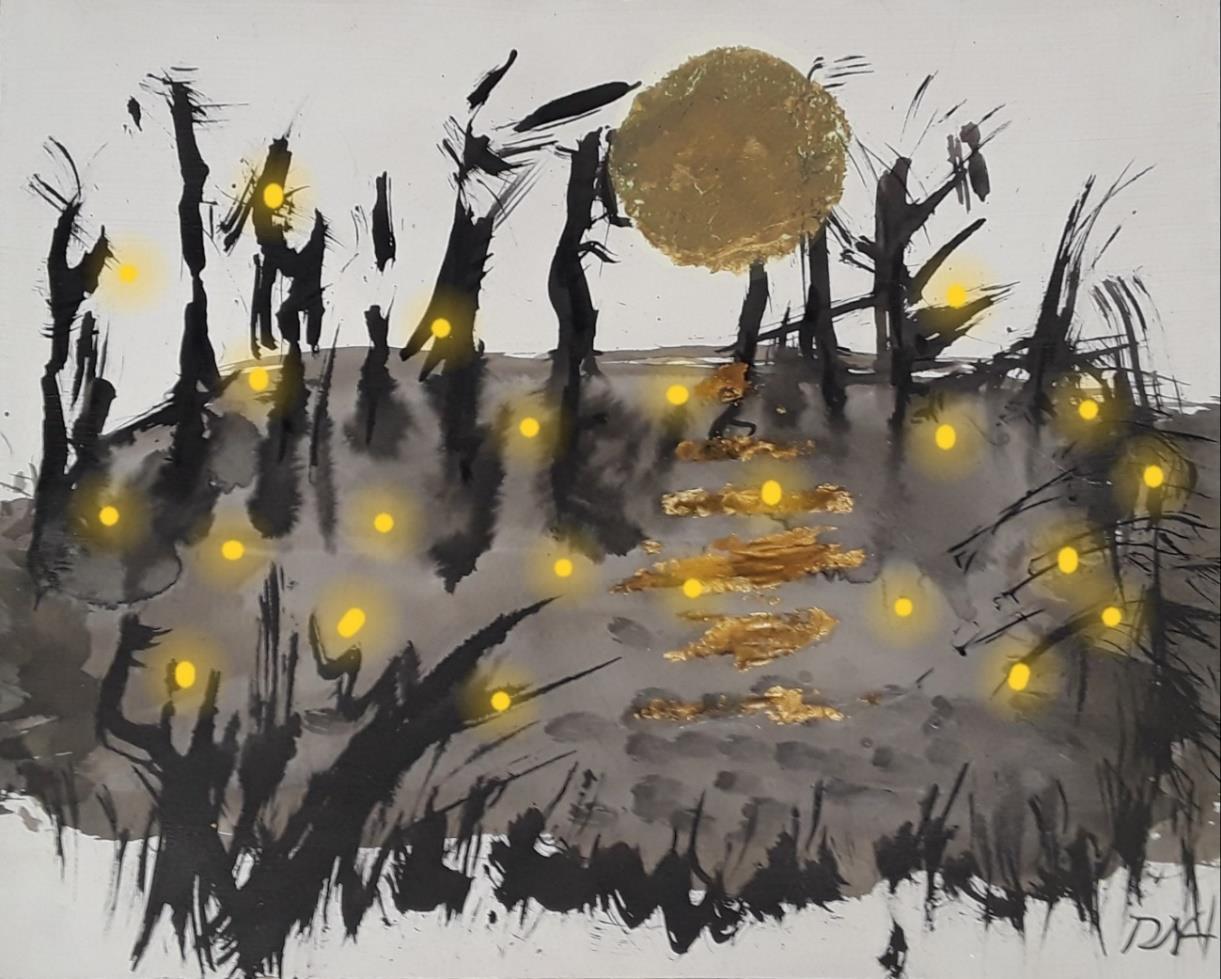Fireflies’ Light
A Magazine of Short Poems
Issue 32 October 2025
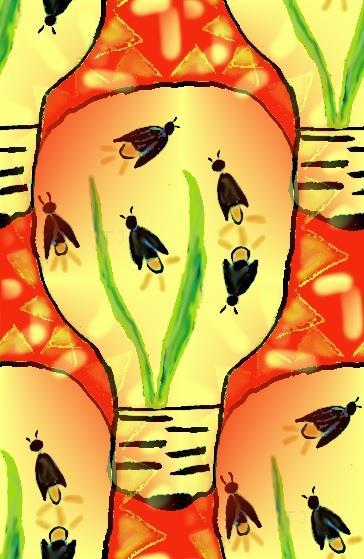

Issue 32 October 2025

Co-Editors: Mason Arledge, John J. Han
Editorial Assistant: Susannah Cerutti
Editorial Consultants: Ben Gaa, C. Clark Triplett
Front Cover Art: Terrie Jacks
Back Cover Art: Donald W. Horstman
Webmaster: Joel Lindsey
Fireflies’ Light is an online magazine showcasing short poems, essays on poetry and poetics, and book reviews. It is published twice a year by the Department of English at Missouri Baptist University, One College Park Dr., St. Louis, MO 63141. Interested poets may submit unpublished manuscripts, not currently under consideration elsewhere, to john.han@mobap.edu. We consider up to ten poems (including collaborative ones), up to two essays on poetry and poetics (150-1,000 words), and up to two book reviews (500-1,000 words) during a reading period. Write “FL - your name” in the subject line (example: “FL - Erin Smith”). Paste your poems, book reviews, and essays into the body of an email. Submit haiga and other artwork as email attachments. Along with your work, we require a 100-word author bio written in the third person and complete sentences. (No sentence fragments or listing, please.) Begin the bio with your name.
Below are the reading periods and target publication dates:
Reading Period
March
September
Target Publication Date
April 15
October 15
Submissions received outside the reading periods will be neither acknowledged nor considered. Short poetic forms include but are not limited to haiku, senryu, tanka, kyoka, sedoka, sijo, somonka, haibun, gembun, lanterne, ABC, cinqku, cinquain, couplet, Etheree, fibonacci (fib), free verse, limerick, lune, octet, quatrain, and triolet. A poem should follow the rules for the chosen form, and the author must identify the form used in the poem parenthetically after the title.
Missouri Baptist University reserves the right to publish accepted submissions in Fireflies’ Light; upon publication, copyrights revert to the authors. By submitting, authors certify that the work is their own. All submissions are subject to editing for clarity, grammar, usage, and Christian propriety. The views expressed in this publication do not necessarily reflect the views of Missouri Baptist University.
Issue 32, October 2025
© 2025 Missouri Baptist University
The fireflies’ light. How easily it goes on How easily it goes out again.
Chine-jo (late 17th century) [Trans. Kenneth Rexroth]
* though wrapped in tissue paper… a firefly’s light
Kobayashi Issa (1763-1828) [Trans. David G. Lanoue]
* what on the other shore tugs at its heart so? in the evening dusk over the Mogami River a lone firefly
Mokichi Saitō (1882–1953) [Trans. Makoto Ueda]
Cherita
53 Keitha Keyes
54 Joanna Ashwell
55 susan burch
Couplets
56 Timothy Daly
Split Sequence
57 Joanna Ashwell
Imayo
58 Todd Sukany
Haiku
59 Srini
60 Tiana Lešnik
61 Eva Novak
62 Jane Beal
63 Gareth Nurden
64 C. Clark Triplett
65 M. R. Pelletier
66 Richard L. Matta
67 Joshua St. Claire
68 AJ Johnson
69 Boryana Boteva
70 Randy Brooks
71 Chen-ou Liu
72 Janet Ruth Heller
73 Miye Kim
74 Amitava Dasgupta
75 Gary Hotham
76 Amber Winter
77 Terrie Jacks
78 Bryan Rickert
79 Ben Oliver
80 John Pappas
81 Oana Maria Cercel
82 C.X. Turner
83 Hifsa Ashraf
84 Maya Daneva
85 Goran Gatalica
86 Anthony Lusardi
87 Ben Gaa
88 Keith Evetts 89 David Green 90 Monica Kakkar 91 Violet Avery Hall
Melissa Dennison Senryu
Srini
Michael Shoemaker 95 M. R. Pelletier
Tiana Lešnik
Richard L. Matta
John Hawkhead
Randy Brooks
Chen-ou Liu
James Aitchison 102 Philip C. Kolin 103 Roberta Beach Jacobson
Amber Winter
Janet Ruth Heller
Curt Pawlisch
John H. Dromey
susan burch
Juliet Hinton
Patricia Hawkhead
C.X. Turner
thomas david
Anthony Lusardi
Tuyet Van Do
Phillip Howerton
Mark Gilbert
Keith Evetts
David Oates
John J. Dunphy
Miriam Sagan
Amitava Dasgupta
Gembun
126 susan burch
Free Verse
127 Richard L. Matta
128 MarthaMaggie Miller
129 Philip C. Kolin
130 Michael Shoemaker
131 Todd Sukany
132 Elizabeth L. Merrick
133 Mark J. Mitchell
135 DS Maolalai
136 Ann Howells
138 Julie Steinbeck
140 John Zheng
145 Laila Brahmbhatt
146 Nathaniel Lachenmeyer Octave
147 MarthaMaggie Miller
148 Phillip Howerton’s Gods of Four Mile Creek: Poems, Photographs, Essays (Golden Antelope Press, 2023) By C. Clark Triplett
154 Jianqing Zheng and Leo Touchet’s Still Motion: Poems and Photographs (Photo Circle Press, 2024) By C. Clark Triplett
160 Ben Groner III’s Dust Storms May Exist (Madville Publishing, 2024) By Cristina Rascón
163 Poetic Sites in Muan, Naju, and Seoul, South Korea (A Photo Essay) Introduced and translated by John J. Han
186 Brief Guide to Short Poetic Forms
195 Notes on Contributors
Richard L. Matta
jacaranda blooms one by one I lay them out suddenly she rolls up the blanket before I form “you”
Joshua St. Claire
inner city the mite on the honeybee in the mallow in the dry clay the clinkety-tink-tink of cup on saucer she notices that I notice the deepening dusk
Randy Brooks
five years now six the camelhair coat father always wore finally fits
Chen-ou Liu
my wife braids our daughter's hair with lullabies... my five-year-old self gazes at Mother's youthful face in the moonlit dark its eyes gleam, jaws slather and teeth gnash... this anxiety wolf stares at me while dizzy, breathing fast
Joanna Ashwell
finding a corner to pass the hours a shared teapot brewing our stories long into sunset
more sunshine on my screensaver the outdoors, indoors… and tonight, the promise of meteor showers
Pitt Büerken
there you are you cannot eat, drink, talk any longer and you want me to decide what happens to you
Curt Pawlisch
northwards fly the great flocks wing-lifted by fears & desires so much like our own our ancient white pine cut from the sky the day you died all I could feel was empty air wicker creel as empty now as decades ago streams stay the same while waters flow
John Zheng
hand-planting rice in the muddy field… the summer sun astride my back as if I’m a water buffalo
dragging barefoot through paddies each step into the thick mud embraces the suck squelch, sludge, squish the sound of mud from lifting each foot compounded by the bubble of heat
bending to handplant in the paddies each step a backward move to harvest the self
gorgeous twilight a faint scent of ripening rice lingering in the shift of hues
C.X. Turner shingle beach I lie still enough to hear how softly night rewinds the sound of us
Mark Gilbert
having been granted the ultimate gift the gift of life the puppet’s wish to be mortal
Debbie Strange
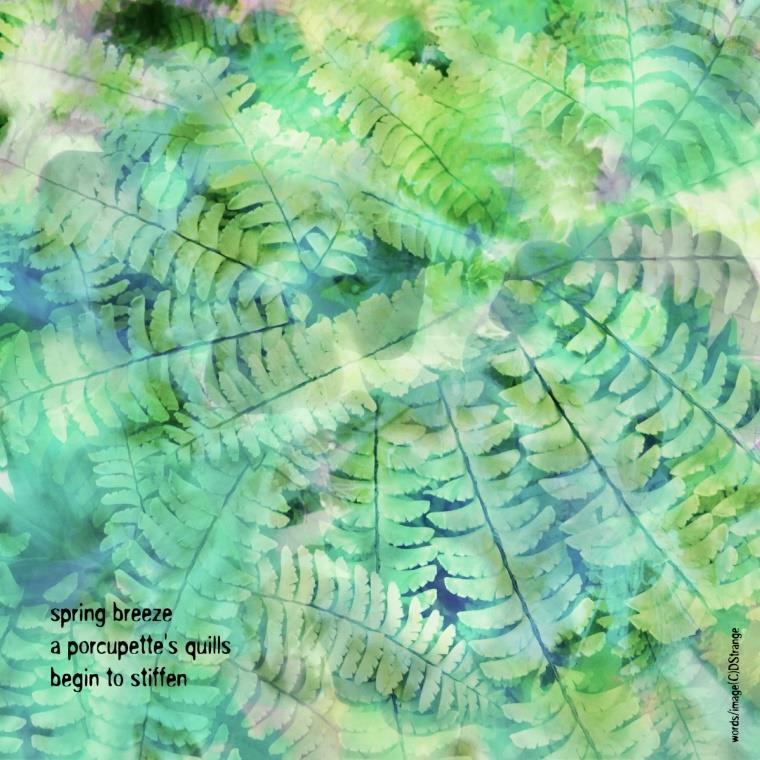
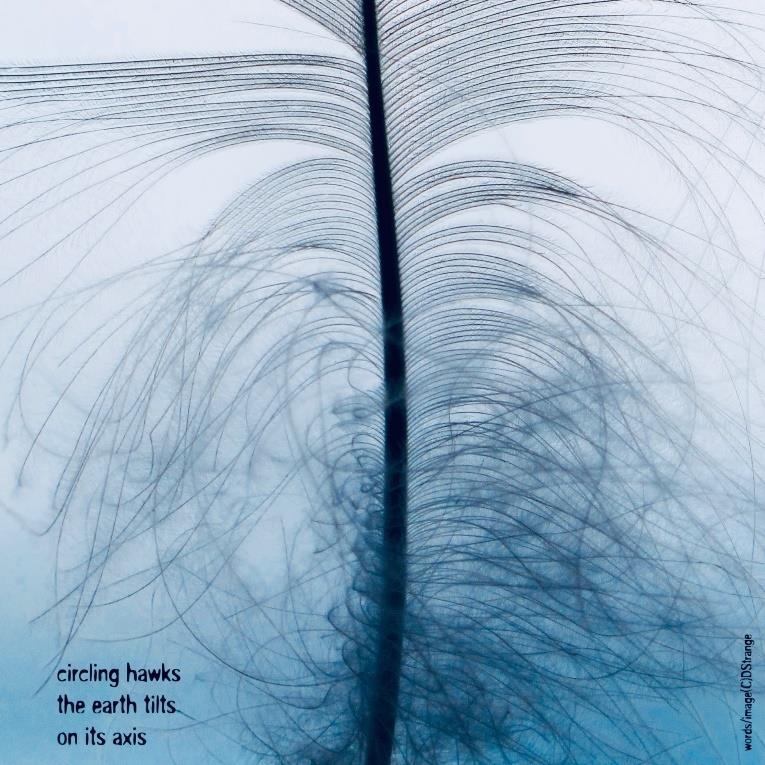

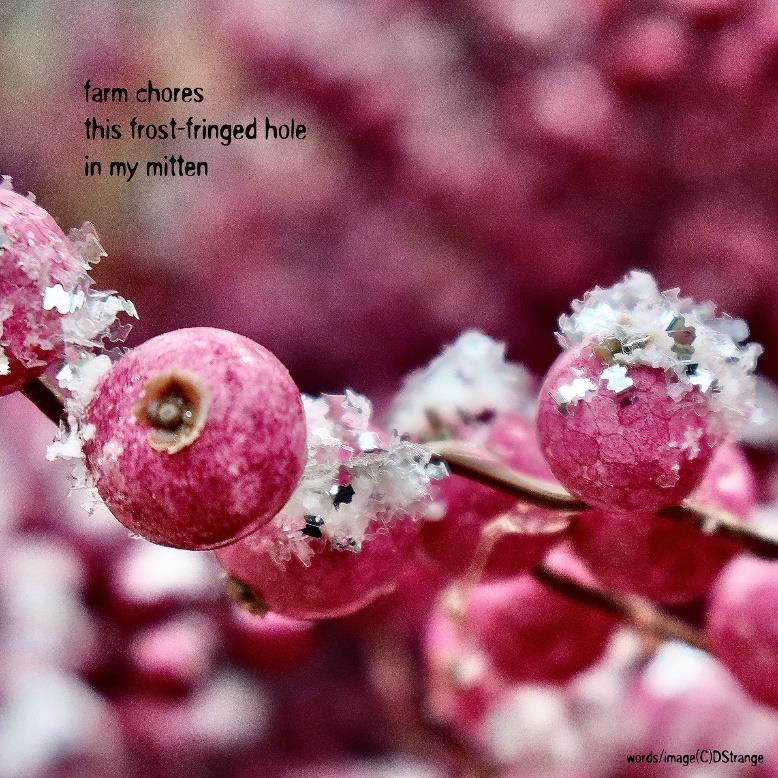

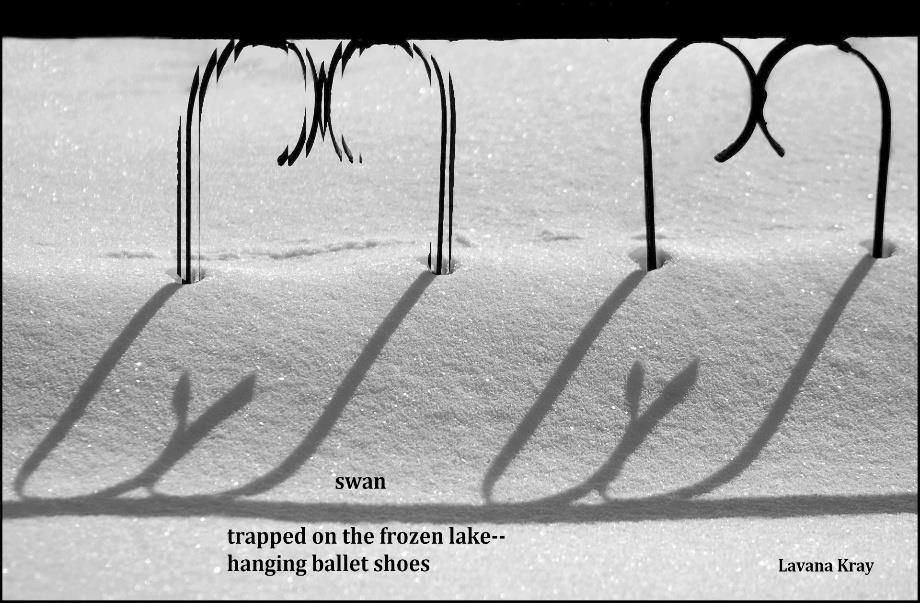
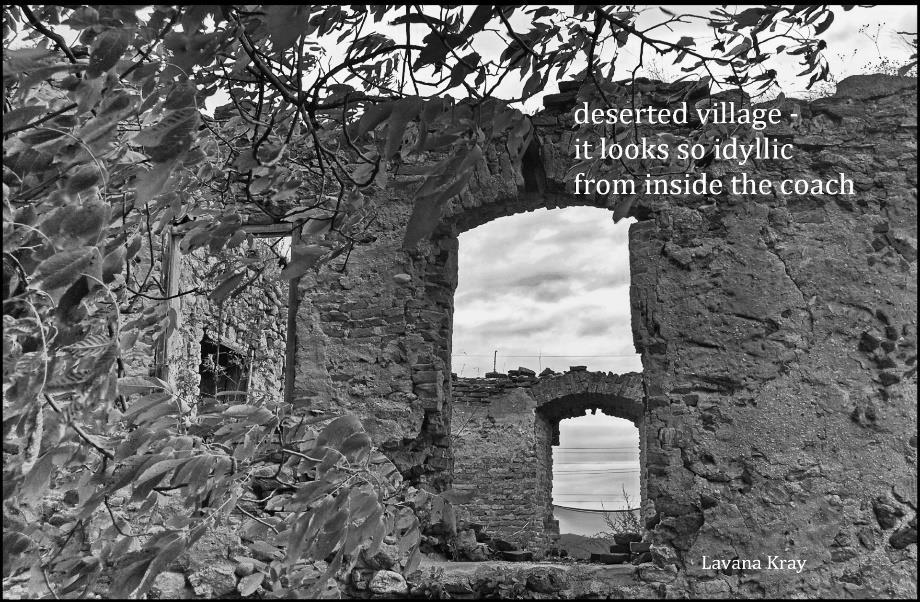
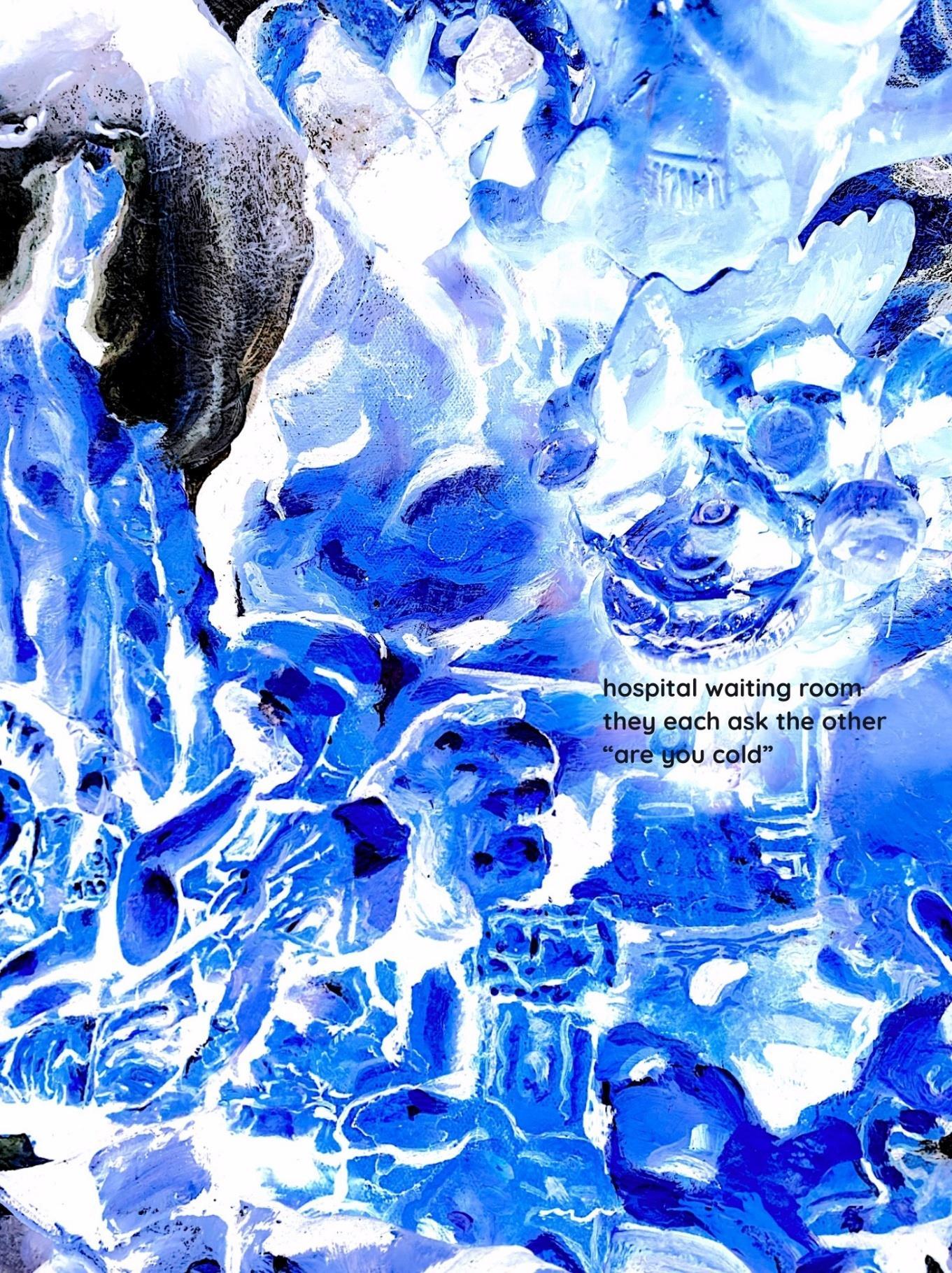
Timothy Daly
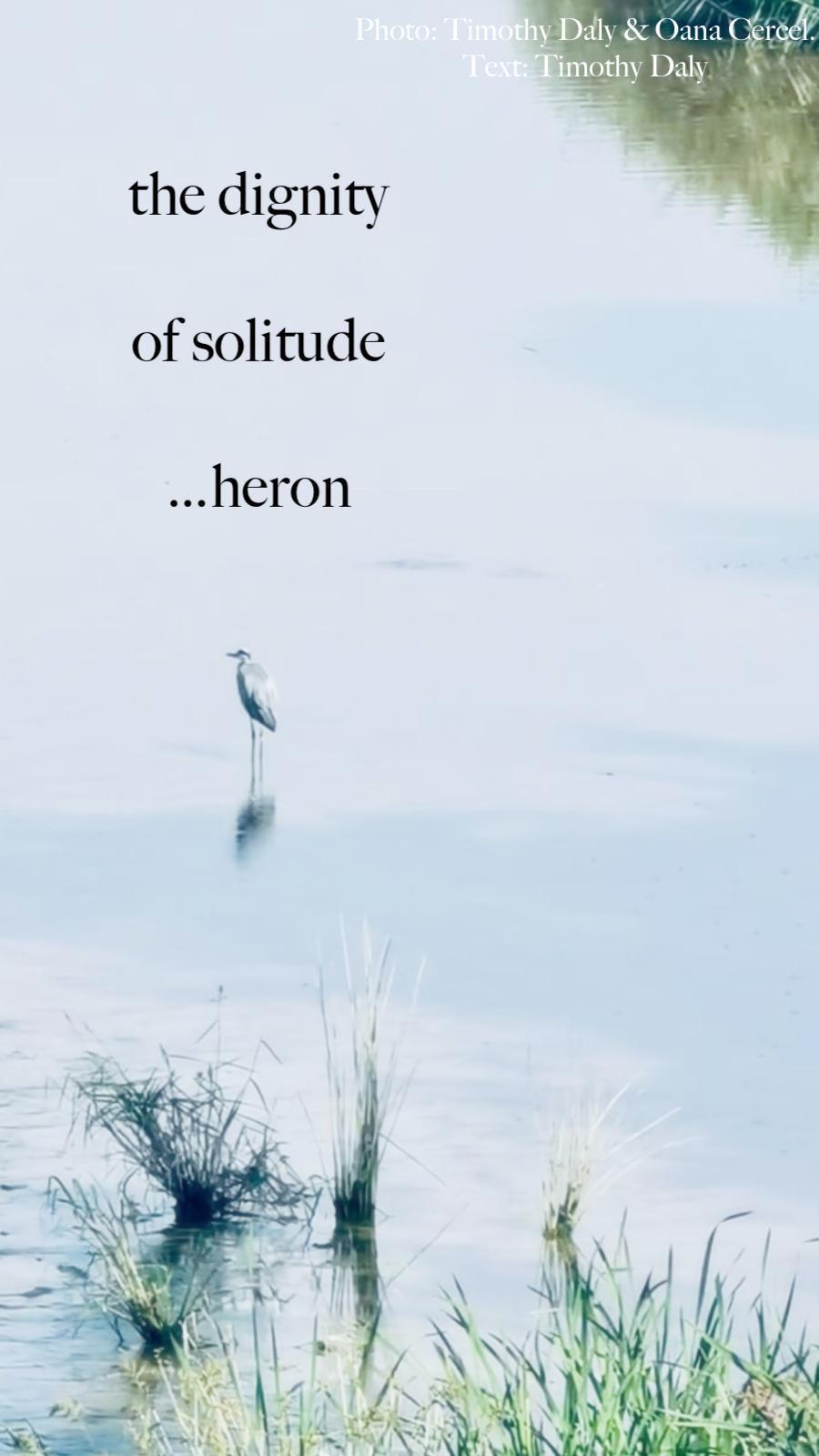
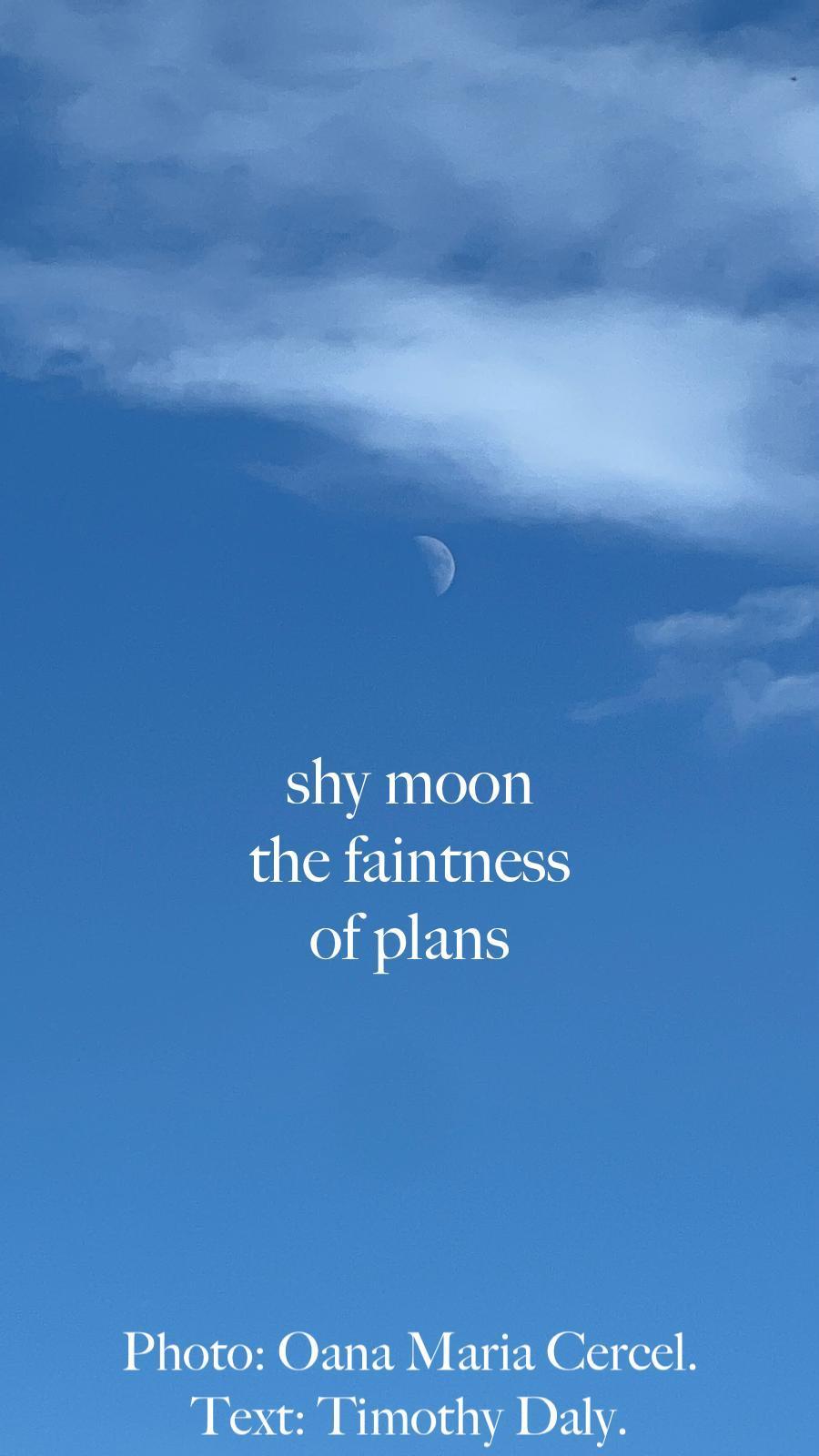
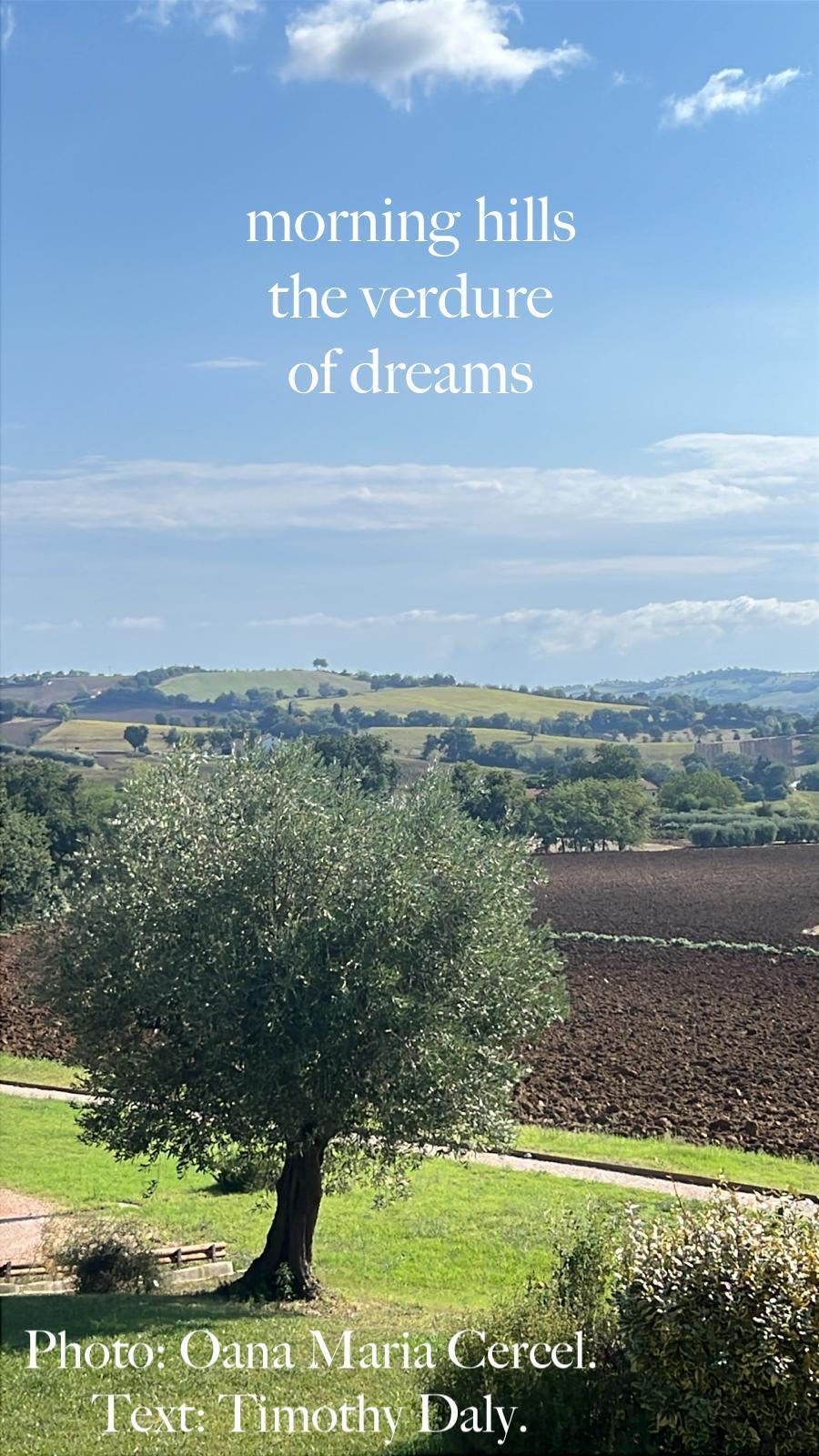

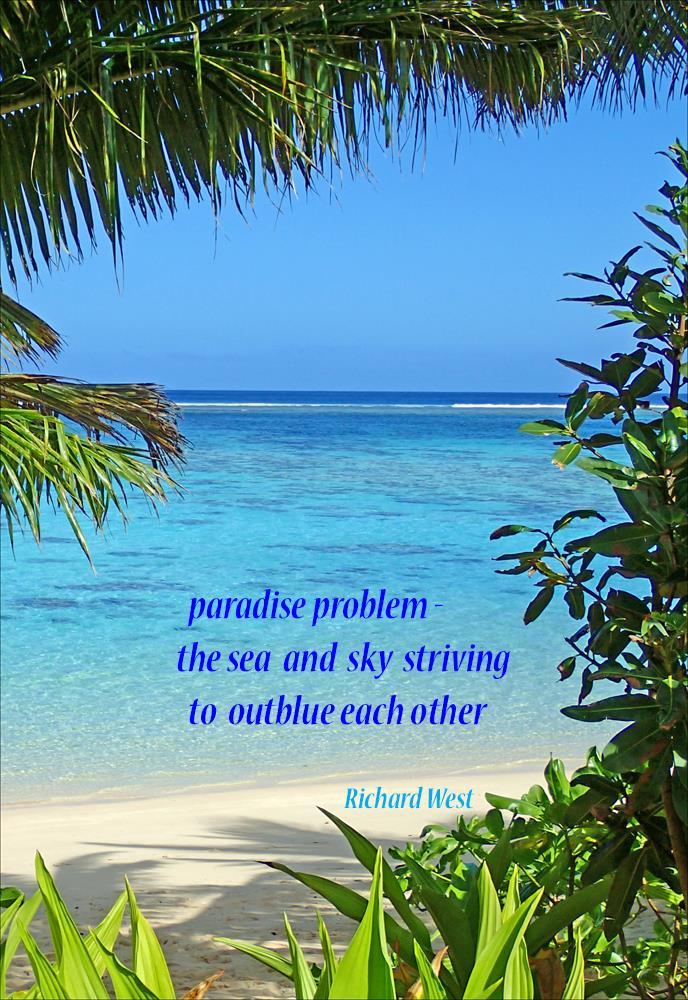
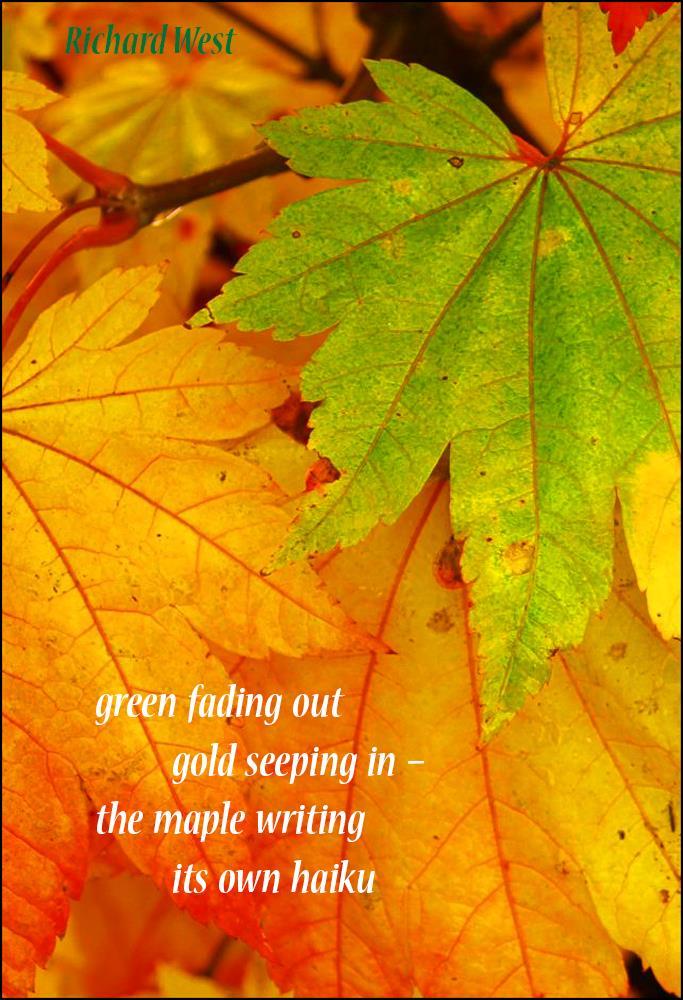
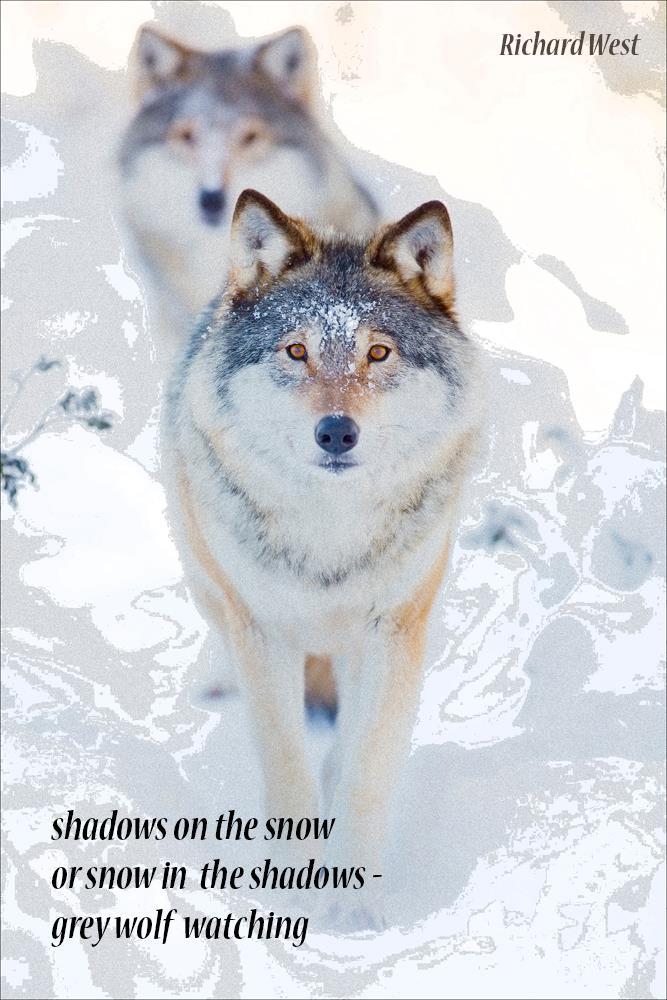

Tsanka Shishkova
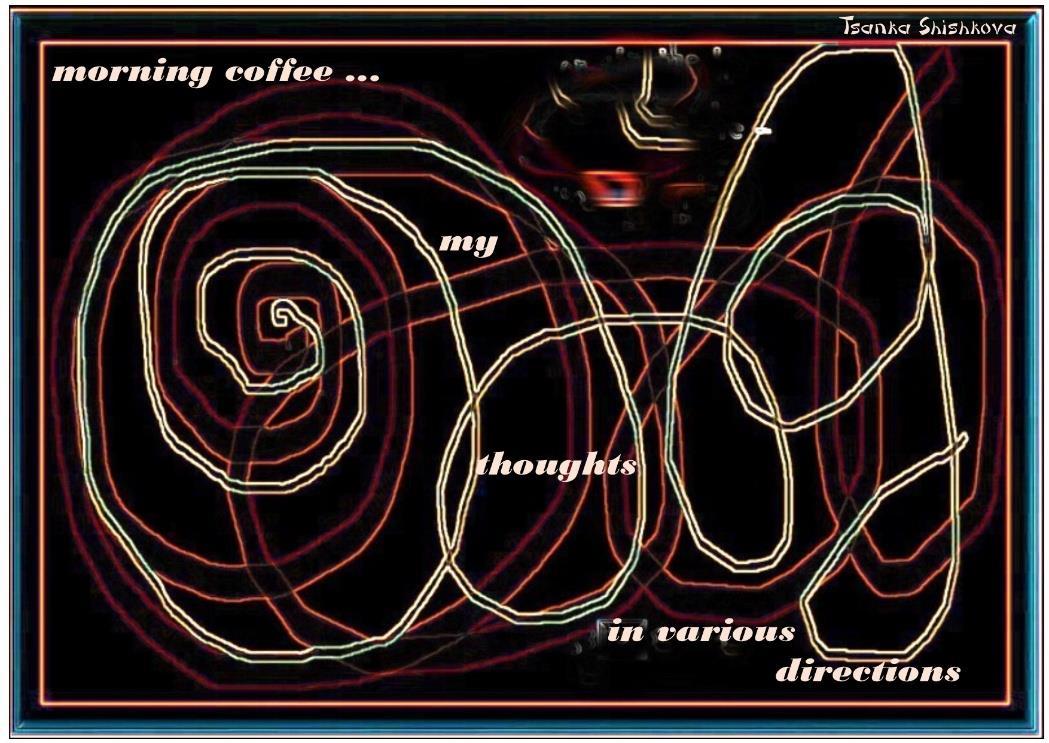
Mark Gilbert
mostly empty space exchanging bishops while two pawns up boring her opponent into submission
John J. Dunphy
"is that the best you can do?" flea market shopper haggles with her confessor for a lighter penance
Bert Molsom
Dull days, skeleton trees shiver above bare earth. Curtains are drawn early against dark nights.
Aware of the dawn light arriving earlier each day. Growth announces small signs of spring.
Lions greet spring’s attempt to offer a promise of growth, good grass, warmth and shelter to lambs.
Showers.
Dampness, not flood, is needed to settle the soil. Feeding seeds, the purpose of rain.
Blossoms, cherry, plum, pear apple, display colours, brighten our view, predict fruit will appear.
Summer shows its changes. The heat draws the moisture through plants to show them all in their glory.
Water, so important for gardens to survive. The rain never comes when it is needed.
Scorched earth, no help for plants deprived of shade, shadows, watering. Wilting lawns become dead grass.
The sun creates longer shadows that stretch across the ground, its path lower as it weakens.
Colours develop shades. The shrubs, trees and hedges that bore summer green are now changing.
There are, at first, half dressed trees losing their summer dress, which sadly may be burnt on bonfires.
Christmas, which starts before it should, will be enjoyed. For some it’s the only time for greetings.
And now,
Demonstrate to Everyone how you Learnt all the numbers you neededAt last.
I see Desire in your Eyes to make those numbers Compute towards all the final Results.
All done.
Pleasure comes now,
Select your welcome prize Examinations now over You won!
Eliana Steele
(A solo tan-renga)
The pressure in my brain A cloud inside my head
Prison of half-formed words
“Who made Man’s mouth?” He asks. Is grace not sufficient?
Eliana Steele / Lauryn Pyatt
It never stops whirling and spinning. I wish I could cut it off, make it stop.
Lies stacked on lies It’s the enemy preying on my demise.
Mark Gilbert
clicking & clacking high-heeled shoes on linoleum
church bells unknown hands practising on a Thursday night
sleeping beauty is still asleep what kind of trouble shall we find put all the pillows in one heap sleeping beauty is still asleep make a big fort with the sheets if she wakes she’ll spank our behinds sleeping beauty is still asleep what kind of trouble shall we find
John J. Han
Joshua St. Claire
At the end of a long day at the zoo, my wife and I usher our three boys, aged 10-13, into the tropical bird habitat. None of us were prepared for the beautiful pandemonium behind the two sets of doors. The air inside the enclosure is flashing with green, blue, yellow, grey, and white. Budgerigars are flapping and flitting all around in a kaleidoscope of color. Cockatoos are perched and whistling from the tops of trees. A dutiful attendant is ensuring all of the visitors are treating the birds with careful respect. He flits around—he might as well have feathers and beak as well—selling little sticks covered with birdseed, sweeping up any spills, and using his small broom to keep any budgies away from trampling feet. My sons tweens and teens, but nevertheless hulking bulls of boys take their seed sticks with relish. Soon, they are covered with a rainbow of budgies. Each one holds the seed steady and lets the birds come to them. They stay calm while the birds flutter up in their face or make a mess of their shirt or nip a finger or thumb sharply to ask for food or attention. They are all smiles with laughs peeping through the twittering language of the budgerigars. One suppresses a squeal as he gently coaxes a cockatoo onto his shoulder. Another giggles, but remains stone-still, as two brilliant yellow budgies peck for spilt seed between the toes of his sandaled feet. I marvel at how quickly the attendant rushes over to swoosh the birds away with his broom.
laughter as light as a feather
BANG. Another family pops in. Dad slumps down on the bench. Mom is busy on her phone. Two teenaged boys in hoodies are jamming with earbuds in. Their red-headed daughter, about the age of my youngest, stomps her foot and declares at the top of her voice MOMMY I WANT TO FEED THE BIRDIES! A cockatoo whistles an alarm call: SHHHRREEEEIIIKK! Within a second, every bird in the enclosure is
perched at the top of the trees and totally silent. A minute later, at least half the birds are swirling around my wife and sons again. The cockatoo comes back to my son’s shoulder. Flashes of yellow, green, blue and white. MOMMY WHY DO THOSE BOYS HAVE ALL THE BIRDS! I WANT ONE NOW! Another alarm call— SHHHRREEEEIIIKK!—and another retreat by the birds. Again, one by one, they creep down from the trees again. My sons are smiling again. The eager tweeting returns and then….AAAAAHHHH! I turn to look. The red-headed girl is screaming and stomping around. Just like my son, there was a bit of split millet around her feet, with budgies pecking around. The attendant couldn’t have gotten there fast enough. EWWW! EWWW! EWWW! BIRD BEAKS! EWWW! GROSS! She starts stomping and stomping. SHHHRREEEEIIIKK! Another alarm call. All the birds retreat, except for one, a mass of green and red at her foot.
through silence the weight of a feather
AJ Johnson
Modoc
Midnight, and we’re bundled against the cold as our convoy rolls out, crossing the alkali lake under the moonless night sky. The asphalt ends and dust billows in the high beams as we climb uphill, rattling up the dirt road into Nevada. At a dark crossroads, we park in the swirling dust and slam our chilled doors to stand and watch patiently as distant sage thrashers sing. In time, the Milky Way, stretched out above the mesa, dims its river of stars as we shout for joy in the aurora’s glow.
noon heat a curlew’s reflection on the playa
Colleen M. Farrelly
Dusk creeps along the forest floor like a timid centipede. A gust tugs at the last leaves clinging to a beech branch and ruffles the feathers of a pheasant flock bedding for the night. A doe and her fawn linger at the ephemeral brook, lapping their last water for the night. As the sun sets, a lone howl resounds from the lake.
sickle moon a curved briar catches a rabbit
Mansions and prep schools and a stray scientology center yield to historical gardens sporting covered benches and the dappled shadows of dawn. At the entrance, dogs roll in last night’s leftover puddles. I stop a second and swish my sneaker through the leaf litter.
knight anole stretching by the litter a park ranger
I climb back to the main boulevard. A strangler fig creeps around a banyan trunk blocking the brick pathway. Lizards skitter to avoid high heels and stroller wheels. A peacock bellows beyond the looming urban sprawl.
sleepy sunrise a gumbo limbo’s shadow hits a stiletto
I wander into a cacophony of Birkin-bag-toting yachters jostling for wait list positions at Michelin-rated breakfast bistros. I opt for a more economical black coffee and macaroon at the artisan coffee shop and watch the ebb and flow of cruise ship tourists mingling with the moneyed.
dawdling dog walkers a maître d’ shoos away the strays
Life Ledger (math haibun)
actuary table I read my fortune cookie
In my field of topology, we count an object’s holes to classify its type and its topological properties. Betti numbers, representing each type of hole, are tallied to assess the object and answer our open questions about it:
Is the object known or unknown? How will a function flow across its surface? Can we morph it into another object with simpler geometry?
buckyball the quantum shifts that limn my life
I tally my own table. The zeroth Betti numbers include points: temporary inconveniences of six-year-old skinned knees, college rejections, and third bad dates in a row. The first Betti numbers count circles: small circles of a morning fender bender or larger circles of another corporate layoff. The second Betti numbers track voids like a rainy April’s evening ache for a long-lost love.
falling robin egg a spring dirge circles my void
C.X. Turner
moon fading somewhere beyond the city noise
When the world frays, when the news presses in like a heavy sky, I step out into the garden. Not much no forest or lake just wild corners where green things lean toward the earth’s slow breathing.
No broadcast reaches here. Only the quiet work of honeysuckle unspooling into light, the slow ripening of tomatoes beneath heavy leaves. I kneel to check the stems for blight, tip one fallen snail gently from its hiding place. A blackbird sings from the shed roof, not for me, but I listen, letting the sound stay with me a while.
Among roots and rain and small ordinary labours, the weight I carry sinks into the ground into the dark work of worms, into the deep heart of things that keep on, untroubled by fear or grief.
cloud-thick dusk the soft click of snails on lettuce leaves
A 7.6 earthquake hit Japan. Is it Godzilla rising?
Funko POP! a new kaiju collectible hits the shelves
* Catching It
“The toilet’s running,” my husband says.
I reply, “It’s ok. It’s training for a marathon.” morning sun the refrigerator’s medal beaming
Keitha Keyes
an old man now
he wants to do things just one more time… his future is shrinking with the close of each day
Joanna Ashwell
all year round this magic meadow highlighting the way back to hope
* a symphony in the stars of coal flecked night a lover calls looping the sky with more song
susan burch the painting hidden underneath the painting layer by layer finding the masterpiece you
Timothy Daly
my first memory the crunch of cornflakes I owe it to that little boy I was to live
* more tabs open than friends to think I almost drowned last year
Joanna Ashwell
star shells wishing again for the return of a dream crafting the sky always orchids left on the sill in place of words an inner hum a neap tide pinned to the shore of enchantment
Being Supreme (Imayo)
“When Pilate therefore heard that saying, he was the more afraid….”
John 19:8
Never hurried, never late; you were unafraid. You challenged authorities in the judgment hall. You held your head high and prayed as the weight of sin. Never again will you know three days of darkness.
* Being Supreme (Imayo reversed)
“When Pilate therefore heard that saying, he was the more afraid….”
John 19:8
You were unafraid; never hurried, never late. In the judgment hall, you challenged authorities. As the weight of sin, you held your head high and prayed. Three days of darkness, never again will you know.
moonless night bats flashing in the starlight
Tiana Lešnik
spring morning my cat splayed out on the car hood
Eva Novak
winter dusk a weeping willow holds the weight of snow
little bee deep in the lavender
two indigo shadows walk the path how blue the sky in springtime!
white-throated swift darting over the green water
yellow and orange flowers unfold in profusion along the fence
three red trumpet lilies glimmer on the hummingbird vine
Gareth Nurden
hunting for crabs in all the wrong places constellations
piecing the moon back together high tide
harvest moon
rice dumpling on my tongue
light within a light
litter the path—the shape of memory
wild strawberries the empty hand is the fullest
Richard L. Matta
such silence snowflakes fill his footprints sunset watercolor knee-deep heron lifting one foot
no time for time white flies
worm’s cry the poncirus moon swinging on a plumb aster field an eastern tailed-blue darting into world’s end
AJ Johnson
backyard roost rusty-gate grackles call in the twilight river fog two ravens navigate by instruments
pink peonies the invisible beauty of her haiku raindrops lost traces of his last letter
Randy Brooks
round and round the once empty lap a winter cat
Chen-ou Liu
yellowing leaves
astir in the night wind ...
trade war news
Janet Ruth Heller
young woman behind her right ear hibiscus blossom
Miye Kim
the return of New Year… again and again without end
Han River a clear cheer echoes with the first snow
(Translated from the Korean by John J. Han)
longest night lost fragrance of her long hair
Gary Hotham
following the headstones we are the whisper
waiting for sunrise each wave with a line in the sand
we make a pit stop peach blossom orchard road

Bryan Rickert
campsite sunrise the deer clear out before we do showing off for me alone first firefly joining the others downstream this fallen blossom
broken bird feeder the squirrel’s chitter almost a laugh
between the neighbors that never talk a three warbler hedge
Ben Oliver pipistrelles dragging shadows under the streetlight black lace lining the hill's crest daybreak facing the gale... the tiercel makes it look easy
we take down the welcome baby sign new moon scallop shell the plash of rain on rain stargazing on the old dock spring peepers
Oana Maria Cercel
showing me a way forward the fireflies
yonder blue the murmuring of starlings
C.X. Turner
first snow the footsteps I follow end at the river twilight lake a dragonfly skims the last light
Hifsa Ashraf
dangling leaf the weight of being alone flooded river the way moon lost its shadow death anniversary the snow flowers bloom in mom’s garden
Maya Daneva
a stone in my sneaker the way this dry summer hurts early evening between me and the horizon cicadas
therapy room–the new sound of rain falling onto windows
autumn downpour–the island getting smaller
Anthony Lusardi
foreclosed house still along the patio path baskets-of-gold
empty flowerpot full of rainwater and mosquito wrigglers
Ben Gaa
morning fog the sudden squawk of an egret
sitting still the length of a lunch hour green heron
lumbering along the midday beach one fat cloud window watching the underbelly of bugs
returning to her place in this poem lap cat
Keith Evetts
haymaking a wedding ring found in the stubble
David Green
dad’s favorite bay the effortless circles of a pelican street names with first initials Italian summer
Monica Kakkar
coolness... tuktuks tooting into the twilight
Violet Avery Hall
end of summer on the whiteboard filtered light
bible study around the campfire lakeside stars
Melissa Dennison
the silhouette of a butterfly september morning
Srini between a scowl and a smile my photo face
Michael Shoemaker
too nervous to cook lime Slurpees and pizza first week at college
M. R. Pelletier
heavy drops of rain an unplanned nap in my chair
Tiana Lešnik
hot chocolate reminds me of you— a hot mess
Richard L. Matta
backtalk our little parrots spread their wings
John Hawkhead
first kiss the escape velocity of red admirals
sudden absence at the end of the story the last page torn out transit camp stars the inner child in a child
Brooks
corn on the cob she butters up our ears
Chen-ou Liu
blowflies around last night's leftovers ... election buzz
James Aitchison
on a frame clack clack— hearing my age
Philip C. Kolin
high school reunion smiles and wrinkles mask tears
Roberta Beach Jacobson
whispers of past employers CV all my secrets no longer fit... ginger jar
childhood spent getting grounded in the garden
the glassiness of the pool bellyflop
Janet Ruth Heller
fallen locust leaves enmity crackles under our feet
Curt Pawlisch
seeming to relent my retriever gives me the bird
John H. Dromey
Snow White Heimlich maneuver end of story
staring contest you blink out of existence
Juliet Hinton
hungry father sells his junkyard scraps for kids
Patricia Hawkhead
blind date he says he loves nature and all that stuff
orha
heat record toppings what is there to relish?
hot dogs
Thomas Smith
Labor Day cook-out always one empty seat for a grandson adrift
family reunion our old dog wags around everyone
Elliot Diamond
108 beads a semi-perfect number still counting
C.X. Turner
boiling water
I wait for the thought to cool
thomas david cutting
right through me— kireji
another wish down the drain prank candles
family reunion grandma picks holes in my ripped jeans
Anthony Lusardi
walk on the beach the sandpiper avoids the waves better than me
Tuyet Van Do
Taichi session among strangers a past patient
Phillip Howerton
Farm Team
(Nine Innings of Senryu)
farm boy playing baseball alone; the barn door strikes out
he steps to the plate, summer grasses do the wave
a fast ball, the barn foundation hits another grounder
impossible catch, witnessed by a crowd of Holsteins
throwing to a tree, double play completed a homerun!
searching for the game ball in a neighbor’s hayfield
he fouls off, the catcher has no chance chore time, the ghost runners linger in the field
abandoned ball field, only the wind circles the bases
Mark Gilbert hanging in the art gallery the perfect apple
Keith Evetts
longest night the fridge too has arrhythmia
things you don’t know about yourself your dog knows young couple she breaks off a tiny bit of his cookie
John J. Dunphy
homeless encampment child does her homework by flashlight
a houseful of strangers woman with dementia attends her family reunion rock star another award for the geologist
Miriam Sagan beneath the double rainbow storm chasers
hospital waiting room mixed with other books a book on afterlife
marmalade sun
some days it’s just an effort to breathe
* I just made trip after trip to dethaw the birdbath only for no birds to come.
21 degrees too cold for my bathrobe
Richard L. Matta
Green Mariachi Guitarist
I sit here in the shade imagine dancing after hours in this garden to guitar tunes. He barely moves in the breeze, flashes a fixed smile beneath his curved succulent mustache. He’s a topography of plants atop mesh and wire, straw like skin on tendons, muscle and bone. Look and see Candelabra aloe and Coppertone stonecrop cover torso and limbs, oh those rosy cactus cheeks. How simple a life. Rooted to greet the sun, listened to… as if those strings could sing.
MarthaMaggie Miller
In the deep where I find myself Darkness reigns with his consort Pain under stars that illuminate in stunning white fireworks flashes stabbing blind, unseeing eyes, where whispers assault tender ears in drumming that echoes heartbeats or ringing that drowns other sounds. Pain periodically peddles sadistic sensory spikes 'til brain overloads and explodes ensuring fealty to Darkness.
Philip C. Kolin
Her Majesty, the African Violet
Africa reigns now In my eastern window
Stirring dreams With her panicles
Regaled in Tyrian purple, White ermine sapphire,
And with a ruby necklace Far beyond Tiffany's wares.
Her velvet-gloved hand Reaches out to mine
As I offer kind water For her odyssey here with me.
Michael Shoemaker
wick farm suspiration
little owls hoot in the bursting ripe plum orchard bees halo vervain I find a mallard feather and honk honk into sunset's arms
* “In the Twilight” by Sir Arnold Bax, Ulster Orchestra
Strings release blue mist and chill over the downhill slope to home. Horns stand alone surveying vast interludes from a peak. Flutes raise sunset thrush song to attic bedroom chamber prayer.
*
June 2030, Paddington Station
backpacker ready and balanced right foot forward and left foot back, resting easy
terminal display appears blinks once and steps forward destination - 2090, Mars Station via moon
Todd Sukany
“unless a grain of wheat falls into the earth and dies....”
John 12:24
I’m not the only flower in your garden, but I am one. I started as a sprout no different than a feeble weed.
You raked the soil, watered and fertilized. You let the sun reach me until pedals bloom.
* Memorial Day
Swirling wind shakes the guide wires taut, relaxed, taut, relaxed, taut. Naked. No red, white, and blue breaks the horizon at high noon. Stout wind taps, turns this flagpole into a chime.
Elizabeth L. Merrick
Harbinger blue jay calls end of summer blue on blue * Midsummer
Sitting on the porch mesmerized by sun and shadow of rustling trees, lilac scent lilting in the air.
Mark J. Mitchell
Every street has its own historian, eager to tell you how things never were but how that never is so much better than this now.
* Marriage
They’ve both seen this movie before, since and again. They never walk out.
*
Short stories mushroom in your head while you hear the TV from upstairs.
Disaster melds with noise from your heater and some images arise while you review your schedule.
All the time you know you’re not asleep, but you are. You only dream that you’re awake.
DS Maolalai
I fill the house up with music and books and you fill it with green plants which don't
put out flowers. you say the light bothers you. I turn out the light. you say that I'm not a good cook, which I know and acknowledge.
I sit while you grill two lamb steaks and some farmerfresh vegetables. I tidy the table of poems. we eat.
Ann Howells
Sun hidden among cloud. Crack in the windshield.
Lone sneaker in the gutter. Two roadkill squirrels. Warning light blinks on. Traffic cones block an accident.
Bitter aftertaste of best man’s toast.
* And This Is My Answer response to WCW’s “This is Just to Say”
You have eaten the Ben & Jerry’s that was in the freezer and which I was saving for Friday’s Bogart retrospective
I cannot forgive Cherry Garcia is too creamy and too comforting
*
zig-zag zinnias like colorful confetti, inscribe acute and awkward angles, unpredictable dots and dashes, indecisive pilgrims flashing summer's Morse code against a field of blue.
* Alvarado Street
Vibration from a plucked guitar string washes the limestone walk, climbs bougainvillea heavy walls, penetrates tiny crevasses where geckos shelter from mid-day scorch.
Julie Steinbeck
I. Dominator 3

Tornado interception truck
Withstands the worst of nature
A rocket-bearing arthropod.
II. August
Second multi-day heat advisory
These dew points are disrespectful. BRB
Praying for an ice age.
III. False Fall
It’s fifty-six degrees!
Rejoice in apple cider, cozy books, and cute sweaters! PSYCH.
Summer part two.
New Horizons Beetle Hunt, 11pm
I should’ve been in bed long ago, But my critterpedia begs me to patrol This virtual island, This beach I’ve delicately dressed, To swing my flimsy net At one Stinking Scarab beetle.
John Zheng
Homebound
dream not a butterfly but mindful petrichor of homeland
~ memory a buoy blinks red to mark the location of the long river ~ porthole view hometown’s sparkling lights cluster for heartbeat ~ homebound my steps like a giraffe
in a loping gait to a thorny acacia
~ home at last a pair of worn shoes also weary at the door
~ another yearend grandma’s papercut fish posted on the door still lively
~ first day in town
old street lined with new highrises estranges me
~ brick street walking slowly to adjust
the feeling of floating
~ walking around a fresh pair of eyes looking for days fading from history
~ rain at dusk chants in seclusion after the temple gate creaks closed
summer vacation
where to go to cheer up?
a yo-yo of indecision
~ porthole view the skyglow over Las Vegas a cityscape blotting out stars
~ silent night in front of Atomic Bomb Dome lanterns float into a line of peace prayers
~ grand bazaar a white peafowl displays his feathers for a new meaning of eye for eye
~ boneyard beach sinewy bodies of driftwood silent in the lapping of time
~ winding road what else deserves a look at each overlook: a stop to stop time or snap a shot?
Laila Brahmbhatt
Under a childhood quilt my memories spin like whirling Sufis
* Lovers’ Embrace in
Red roses from a bridal palanquin warm in your hands as we embrace
* Open the Door He stands at the door I cover my face my heartbeat is loud louder than his footsteps
Nathaniel Lachenmeyer
first planting
under a gray and heavy sky she clasps in her tiny happy hands the cradle of our best tomorrows
MarthaMaggie Miller
Everglades drenched in petrichor silently wait for sun to reign. Birds rise to serenade Shakespeare after clouds release pouring rain. Humidity cloaks the landscape as storms lose their hold on the blue and radiance filters through leaves, stage lights for Taming of the Shrew.
Howerton, Phillip. Gods of Four Mile Creek: Poems, Photographs, Essays. Golden Antelope Press, 2023.
ISBN: 978-1952232831 (paperback). 124 pages, $18.95.
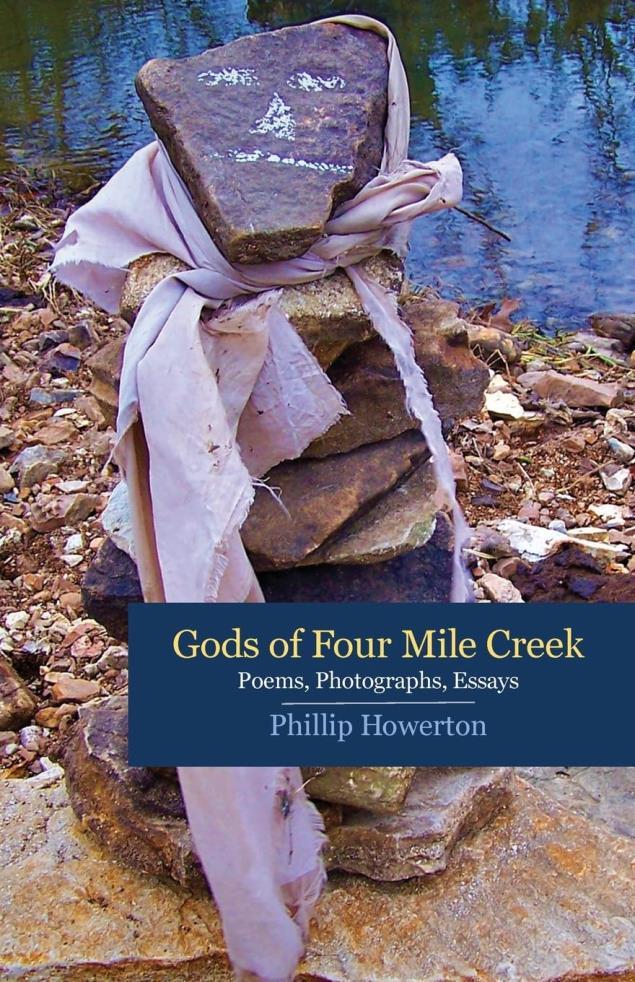
Reviewed by C. Clark
Triplett
This collection of essays, photographs, and poems is deeply rooted in the soil and spirit of the Ozarks, much like its author, poet Phillip Howerton. A sixth-generation Ozarker who grew up on a farm in southern
Missouri, Howerton writes with a keen sensitivity to the textures of land and memory. His poetry offers readers a direct, sensory encounter with place, while the personal essays evoke the nostalgia of home, family, and rural life: experiences that resonate with anyone shaped by “the country.” Complementing these written reflections, the photographs draw readers into a past that feels at once distant and familiar. Threading through these depictions is Four Mile Creek, a restless current that becomes both symbol and witness, stirring emotions of joy and grief and reminding us of the fragile interplay between human choice and forces beyond our control.
Howerton currently serves as professor of English at Missouri State University–West Plains. He is co-editor of Cave Region Review and general editor of Elder Mountain: A Journal of Ozark Studies. His earlier collection, The History of Tree Roots: Poems (2015), exemplifies the same sensibility that runs throughout his work: attention to farm life and the capacity to draw meaning from its seemingly ordinary details. Chores, animals, tools, and daily routines become touchstones for larger reflections on human experience. Both his poetry and prose are grounded, tactile, and profoundly rooted in the land and culture of the Ozarks.
The title Gods of Four Mile Creek is first articulated in the opening poem of the same name, which is preceded by two photographs, “Spring Flood, 1966” and “Summer Drought, 2022.” Together, these images and the poem function as a kind of prelude or summary statement for the entire collection. The poem personifies the creek as inhabited by a pantheon of gods; not benevolent deities but rather capricious, unpredictable forces that shape both the land and the lives bound to it. With a touch of irony, the poet compares these local gods to their “Greek cousins,” (xix). However, unlike the figures of classical mythology, they offer no wisdom or empathy. Instead, they are whimsical, destructive, and careless. Still, the relationship between poet and creek remains intimate and enduring. The creek is not a distant abstraction but a daily presence, shaping the land by depositing gravel across the bottom pastures, “piling / leaves and trash in young willows, whispering / to me in morning darkness, and threatening / my footing as I waded to fetch the cows” (lines 14-17).
Like much of the collection, this poem situates local, lived experience within a mythic framework of gods and fate. It suggests that the natural world, however small or familiar, exerts its power with the same indifference as the ancient deities. The gods of the creek may appear petty and cruel, yet they remain sovereign over those who depend on the land. Humans, like fish, return to them again and again, sustained and imperiled by the very forces that endanger them.
Closely tied to the collection’s theme of human struggle against life’s hardships are the enduring artifacts fashioned by human hands; objects that persist despite the “ancient antics of flood and drought…” (line 13). In the ekphrastic poem “An Old Corner Post,” the weathered, gray fence post stands as a monument to the past, described as “too stubborn, too rooted to move” (line 6). The poem unfolds like a quiet elegy, casting the fence post as a figure of endurance, memory, and obsolescence. Through personification, the post appears aged and neglected, with “wild hairs of wire / no one bothers to trim” (lines 2-3), evoking the image of an elderly person who has outlived his time, left behind in a place once alive with work and community. The poem ultimately laments the fading of rural life, leaving only traces: “[…] cedars and wild roses, / marking where fence rows once led / across fields and deep into these hills” (lines 12-14). Just as the creek’s gods embody nature’s unpredictability, the corner post embodies time’s erosion of human effort, yet it reminds us that remnants endure for those willing to notice.
Across the old farm, artifacts remain that tell the story of both the hopes and hardships of rural life. In “The Grade A Milk Barn,” Howerton offers a stark image of how the utilitarian nature of modern farm work can lead to sterility. The poem contrasts the milk barn with its older sister, the loft barn, which is remembered as picturesque and alive with animals, shelter, and the intimate rhythms of farm life. By contrast, the milk barn
[…] will never be pretty or picturesque, and memories will not soften her lines, for no one shared hay-laden loft days or manger nights with her, and she offered no shelter from storms nor comfort in birth and death. (lines 2-7)
Instead, it is “a small factory (line 8),” functional but devoid of warmth or memory, marked more by absence than presence. It is not a place of stories or shared life, but of blunt utility, stripped of intimacy or romance.
“The Grade A Milk Barn” thus suggests more than the character of a single structure; it reflects a cultural transformation. Where the loft barn embodies warmth, memory, and myth, the milk barn becomes a symbol of sterility and inertia. Like the opening poem, “Gods of Four Mile Creek,” which imagines the creek as capricious and destructive, this piece shows how even farm buildings can embody a shift from a storied, enchanted past
to a hollow, utilitarian present. In the contrast between the two barns, one resonates with myth while the other stands petrified.
In Gods of Four Mile Creek, people are as integral to the landscape as the fields, barns, and waterways. They embody the endurance and identity of rural Ozark life. In the poem “The Grandmother,” Howerton offers both a portrait and an elegy, capturing a life defined by hardship and resilience. The figure of the grandmother feels at once particular and universal, rooted in biography yet shaped into an archetype of endurance. Her story is told without embellishment, in plainspoken detail that heightens the emotional weight of the poem:
She came to adulthood during the depth of the Depression, married at eighteen, gave birth to seven children. Suddenly a widow, and then came a world of war, a son killed in Korea, another sent to Nam…. (lines 1-6)
The poem’s emotional center emerges in her own words: “I always had my hands” (line 6). Her hands become a symbol of labor, persistence, and selfworth, an image that gathers force as the poem closes. In her final winter, lying in bed, she watches her son stir the fire in the stove: […] her hands opened and closed, / with an instinct to stir that bed of coals, / to build one more fire against the night (lines 13-15). Even in death, the body remembers its long vocation of work, tending, sustaining, and creating warmth against both the winter cold and mortality itself.
Some figures in Howerton’s poems resist the hardships of rural life by building things meant to last. The ekphrastic poem “Peele’s Barn” responds to a photograph of the skeletal interior of an old barn, its massive beams still supporting the roof despite their age. The poem memorializes not only a structure but also a way of life. It begins with a tribute to craftsmanship: “Old Man Peele was a master carpenter, / and he laid the entire barn out in the grass / before neighbors arrived to raise it” (lines 1-3). Peele’s skill was so refined that nails were unnecessary; every mortise and tenon fit so perfectly that the barn would endure for generations.
The building of the barn becomes a communal act, neighbors gathering in the spirit of older traditions when hard labor was shared. Yet its durability: “outlived the old man / and his family, and outlived the mode of life / and farm that produced it” (lines 11-13). In the final stanza, the
poem shifts into the present tense, where the barn still stands, though no longer as a site of production. Now it is only:
[…] a poet or folklorist (who) is found foolish enough to trust its loft ladder and loft floor and to peer through its cracks at the lost world outside. (lines 13-16)
The poet’s cautious climbing conveys both reverence and risk, as if recovering vision requires physical and imaginative effort. In this way, the barn becomes a monument to human skill and a relic of a vanished world. Its endurance is tinged with irony: though it once stored hay, tools, and animals, it now holds only memory. The poet and folklorist, keepers of stories, serve as its caretakers. Like other works in the collection, “Peele’s Barn” underscores the fragility of human life against the endurance of artifacts. If, like the poet, readers are willing to look closely, the traces of the past can still be glimpsed through its cracks from the outside.
While much of Gods of Four Mile Creek dwells on hardship and the unpredictability of rural life, not all of it is somber. Several pieces look back with delight and nostalgia at the people, animals, and structures of farm life. One such essay, “Off the Farm,” recalls a childhood memory that captures a sense of wonder and playfulness. At ten years old, the author joined his family on a trip to Springfield, Missouri, fifty miles away, to deliver a crop of wheat to the feed mill. Much of the adventure centered on riding in the back of a “1951 Chevrolet two-ton flatbed” truck with his older brother Tom (97). Faded and weathered, the truck nevertheless became a vessel of freedom as the boys perched atop the wheat sacks. Already “chigger bitten and briar scratched, lean and hard as fence posts, and brown as ticks” from summer work in the fields (Ibid.), they felt ready for anything.
The ride itself became the highlight: “It was great fun…to stand in the back and let the wind blow around us, to tease the dogs that run out to bark, and to grab at the branches and leaves hanging over the gravel road” (98). In that moment, “all the world was well” (Ibid.). Yet the trip took an unexpected turn on the steep incline of Northview Hill, when a brown van pulled alongside the truck. A woman rolled down her window, smiled at the boys, raised a camera, and snapped their picture before laughing and speeding away. For the younger brother, this moment lingered. His older brother offered no explanation, and his mother’s knowing laughter only
deepened his curiosity: “why would a stranger want a photograph of us?” (Ibid.).
The author admits that he remembers little about the rest of the trip. What endures is the memory of that passing encounter, which later took on new meaning. Over time, he realized what the woman likely saw from her perspective, though the mystery remains part of the story’s charm. The essay closes with a wistful line: “I would love to have a copy of that photograph” (99).
More than a simple childhood reminiscence, “Off the Farm” demonstrates Howerton’s gift for turning an ordinary moment into a meditation on perception, identity, and memory. Placed alongside poems of hardship, the essay broadens the collection’s emotional range, showing that rural life was not only marked by labor and loss, but also by moments of play, delight, and wonder.
Gods of Four Mile Creek is a richly textured collection that captures the land, people, and culture of the Ozarks through a blend of poetry, essays, and images. Howerton, a sixth-generation Ozarker, writes with deep sensitivity to farm life, memory, and place, grounding his work in both hardship and joy. Poems such as “Gods of Four Mile Creek” and “An Old Corner Post” highlight nature’s unpredictability and time’s erosion, while others like “The Grade A Milk Barn” and “Peele’s Barn” contrast sterility with craftsmanship and endurance. Figures like “The Grandmother” embody resilience in the face of loss, while essays such as “Off the Farm” recall playful, nostalgic moments of childhood. Together, these works reflect both the fragility and endurance of rural life, balancing elegy with pride in craftmanship, and a will to keep going.
Given the limitations of time and space, this review can only gesture toward the breadth and depth of the collection. Many other poems, essays, and photographs merit closer attention, as each contributes to Howerton’s nuanced portrayal of Ozark life and its enduring meanings.
Zheng, Jianqing (Poet), and Leo Touchet, (Photographer). Still Motion: Poems and Photographs. Photo Circle Press, 2024. ISBN: 978-1-7324433-9-6 (paperback). 64 pages, $15.00.
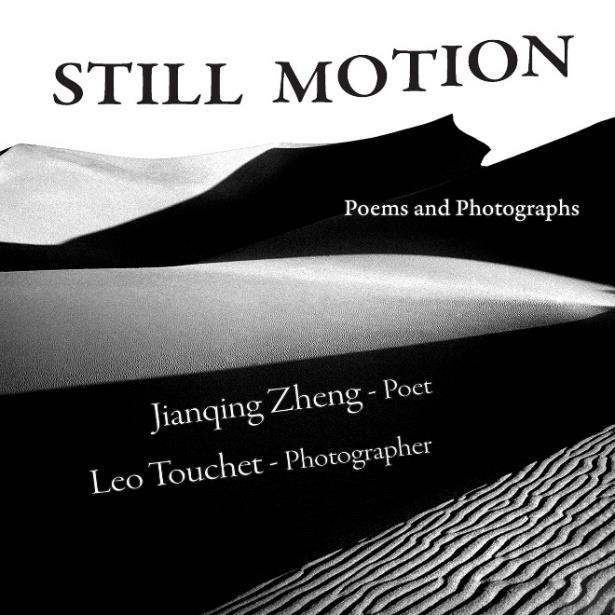
Reviewed by C. Clark
Triplett
This collaboration between poet and photographer is more than a simple pairing of words and images; it is a fusion of imagination and creativity. Zheng’s ekphrastic writing moves beyond merely interpreting or retelling a visual scene; it is a sensory process that generates something entirely new through the interplay of poet and photographer. Many of the poems respond to Touchet’s black-and-white photographs from his Chasing Shadows collection: “The composition of his photos exhibits beautiful shapes made effective by light and shadow, with a tension between the fluidity and tranquility of the dunes that inspires ekphrastic writing” (6). The exchange between the two artists becomes a kind of dance, leading to experimentation with verse and vision that results in a sensory delight.
Zheng, a literary scholar, poet, and chair of the English Department at Mississippi Valley State University, is the author of numerous poetry
collections, including The Dog Years of Reeducation, A Way of Looking, The Landscape of the Mind, Enforced Rustication in the Chinese Cultural Revolution, and Soulful Dancer: Photographs and Poems (with photographer William R. Ferris). He has also published five poetry chapbooks and e-chapbooks, as well as photo essays in journals such as Arkansas Review, Fireflies’ Light, and The Southern Quarterly, among others.
Leo Touchet is an accomplished professional photographer whose books and monographs include Rejoice When You Die, Children Among Us, People Among Us, Flowers in Black & White, Chasing Shadows –Desert Sand Dunes, The Life of a Duck, At the Races, and Duet – Poet and Photographer. His work has been exhibited at institutions such as the New Orleans Museum of Art, the Houston Museum of Fine Arts, the Hilliard Art Museum, the Bibliothèque Nationale (France), and the Chase Manhattan Collection, as well as in numerous exhibitions worldwide.
Over the years, Zheng and Touchet have met on various occasions, forging a creative dialogue. One of Zheng’s journeys took him west to the vast sand dunes, a landscape both austere and alive with shifting light. There, he witnessed firsthand the photographer’s challenge: to capture the fleeting dance of light and shadow as the sun traces its arc across the sky. The work presented here is the fruit of those encounters, a melding of image and word in which Touchet’s visual compositions find their counterpart in Zheng’s poetic forms.
The concept of “still motion” refers to a technique in which a sequence of images is displayed rapidly, frame by frame, creating the illusion of movement. This is like stop motion used in horror films where a rapid succession of images heightens tension and intensifies the moment. This fast-paced visual rhythm can provoke an overwhelming sensory experience that fuels the imagination. At times, it may even produce blended sensory perceptions known as synesthesia by activating intersecting cognitive pathways. In these ekphrastic poems, where vision and verse interact with unusual intensity, Still Motion expands the viewerreader’s world, opening new horizons of perception and expectation.
These sensory juxtapositions open new dimensions in both photographic and poetic expression. They are evident in many reflective, imaginative poetic responses to great works of art. For example, in her Men in the Off Hours, Anne Carson devotes a series of nine poems to Edward Hopper’s Nighthawks. This silent urban streetscape evokes in many viewers a profound awareness of the emptiness that can permeate city life. Carson intermingles her verses with quotations from St. Augustine, whose
meditations on time offer a philosophical counterpoint (Craven). In her reading of Hopper’s painting, the passage of time creates an emotional distance between the diner’s figures, instilling a quiet sense of separation:
On the street black as widows nothing to confess our distance found us… (qtd. in John K.)
As Craven suggests, Carson’s use of staggered, ladder-like lines visually echoes the painting’s interplay of shadow and light, forging yet another link between visual art and poetry and enriching both.
The poems in Still Motion reveal a rich interaction between photography and verse. Zheng employs a variety of forms: free verse, shaped poems, prose poems, haibun, jazz pop, and haiku to create a precise resonance between each image and its verbal counterpart. Many of the photographs depict sand dunes, their contours captured in moments of fluid stillness, where light and shadow ripple into wave-like shapes that at times seem almost magical.
In the prose poem with haiku, “Sight to Sight,” Zheng likens this still movement to “the feminine beauty of dunes,” comparing it to “a noodle strap of a dress worn to a gala… dangling to attract the eye” (21). Here, the dunes are personified, coming alive through both imagery and rhythm:
afterglow her curving line slants on sand (Ibid.)
In the poet’s vision, the contrast of darkness and light within the photograph evokes the graceful slope of a human shoulder.
A classic ekphrastic form is found in Zheng’s poem “Questions from Seeing.” The poet creates a metaphor to interpret an enigmatic photographic image of a sand dune. In the poem, the prominent shadow in the photograph is metaphorically transformed into “a mummy of an Egyptian Pharaoh,” and the rippled sand becomes “a pyramid labyrinth”:
The background shadow looks like a mummy of an Egyptian Pharaoh and the foreground sand ripples like a pyramid labyrinth in darkness
If ancient burial means eternal peace, why should it be disturbed? But after the buried is unearthed for research or exhibition, what is seen after a mummy is unwrapped cautiously? An object for preservation study or a body as dry as a dead Joshua tree? As you walk near a mummy case in the museum, do you shudder at those big, painted, staring eyes? Who has a stronger desire to see a researcher, a museumgoer, or the dry mummy who may be able to silently watch us doing whatnot? (13)
The poet’s imagination inserts a mythical narrative upon a visual landscape. The interpretive frame moves in both directions—from photograph to poem and from poem to photograph. Light and shadow evoke conceptual contrasts between life and death, blindness and seeing. Lines 5-6 shift from description to moral inquiry: “If ancient burial means eternal peace / Why should it be disturbed?” This transition reframes the sand dune as a burial site, raising a serious question about respect for the dead. The observer may regard the dune much as an archaeologist regards a mummy that is “unwrapped cautiously” as “an object of preservation study.” Yet even “a body as dry as a dead Joshua tree?” may hold more meaning than the eye initially perceives. Some viewers may shudder when confronted with those “painted, and staring eyes,” suggesting that the dead may observe us as much as we observe them.
The poem’s final question is unsettling: “The dry mummy who may be able / to silently watch us doing whatnot?” The syntax here is deliberately strange, mirroring the incompleteness of human thought about the afterlife. It raises the possibility that curiosity about the dead and the afterlife is not a one-way gaze.
Ultimately, the poem is a meditation not only on the beauty of the dunes but also on the ethics of violating the dead, where burial rights are overridden for research or simple observation. It explores humanity’s hunger to see what is hidden, while suggesting that the act of seeing may be reciprocal. The photograph of a sand dune thus becomes an entry point into
reflections on mortality and the uneasy intersection of science, art, and respect for sacred rituals.
This collection of photography and poetry is not solely about sand dunes; it also features distinctive images of real-life cultural situations that invite thoughtful reflection. Zheng’s ekphrastic poem “Wonder” exemplifies how a poem can paint a verbal picture that captures a fleeting moment. The accompanying photograph depicts two African American boys of elementary school age standing among a group of people on Bourbon Street in New Orleans. The smaller boy is playing a small instrument. Both boys gaze toward something in the distance that has captured their attention. Zheng recreates this moment through his own poetic vision:
Bourbon Street, a smaller boy playing a small trumpet looks up, a taller boy pats the small one on the shoulder, saying with his other hand pointing to the direction:
“Bro, it’s there.” Their wide eyes explore something so new to them… (33)
“(A) smaller boy / playing a small / trumpet looks up” emphasizes not only the diminutive size of the instrument but also the vulnerability and freshness of the boy’s experience. His upward glance suggests a focus on something intangible perhaps an opportunity, a spectacle, or the sound of music drifting through Bourbon Street. The taller boy’s pat on the shoulder functions as a guiding gesture, akin to that of an older sibling. His pointing hand frames the scene, directing both the smaller boy’s and the reader’s attention toward whatever is “there.” The line “Bro, it’s there” grounds the poem in vernacular speech, lending it concreteness and authenticity. The ellipsis at the poem’s end implies that the moment is ongoing: the “wonder” remains unknown, yet the photograph freezes the instant just before the boys fully comprehend what they are seeing.
Zheng’s poem does more than describe the photograph; it interprets it through the lens of childhood curiosity and shared discovery. The small trumpet may also symbolize a beginning, a first step into an imaginative life. The pointing hand suggests movement forward, not only along Bourbon Street but also toward life’s unfolding possibilities.
While each photograph and poem in Still Motion merits its own sustained reading, the scope of this review allows for only a few representative examples. Yet even these brief glimpses reveal the depth and range of Zheng and Touchet’s creative partnership. Their work invites readers to linger over details, to experience the push and pull between word and image, and to allow their own perceptions to shift in the process. In this way, Still Motion functions as more than a book of poems and photographs. It becomes a space for dialogue between art forms, where light and shadow converse with metaphor and memory.
In conclusion, Still Motion succeeds in embodying the very concept its title suggests: the paradox of motion captured in stillness, and stillness infused with motion. Zheng’s deft poetic responses do not merely mirror Touchet’s photographs; they expand upon them, infusing each frame with narrative possibility and emotional resonance. Touchet’s lens, in turn, frames the poems with visual precision, offering moments of beauty that linger in the mind. Together, poet and photographer have crafted a work that not only celebrates the ekphrastic tradition but also renews it, reminding us that the richest art is born where vision and language meet.
Craven, Jackie. “What is Ekphrastic Poetry: How Poets Engage with Art.” Thoughtco. Nov 2018. https://www.thoughtco.com/ekphrasticpoetry-definition-examples-4174699. John K. “Poem: Anne Carson.” J’S Theatre. April 2018. https://jstheater.blogspot.com/2018/04/poem-anne-carson.html.
Groner, Ben III. Dust Storms May Exist. Madville Publishing, 2024. ISBN: 978-1-956440-85-0 (paperback). 106 pages, $19.95.
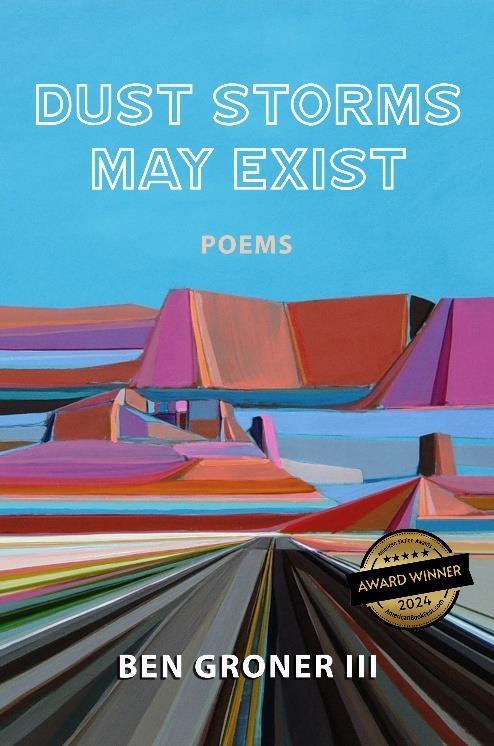
Reviewed by Cristina Rascón
“One could make the case that more than / anything else, this country is a road,” shares Ben Groner III in his poem “When a Country Is a Metaphor.” Winner of the 2024 American Fiction Award for Religious Poetry, Groner’s book, Dust Storms May Exist, unravels a 10,000-mile road trip primarily through the southern states of the “Untied States,” as he notes in a clever wordplay that reappears throughout the book. The poems also travel beyond the U.S., venturing into Chile, Argentina, and the Netherlands. As readers, we accompany Groner on a journey of poetry,
landscapes, and fleeting moments poem by poem, city by city as if each verse were glimpsed through a car window.
After reading Dust Storms May Exist, I came to believe that, more than anything else, this book is a road. In the aforementioned poem, Groner writes, “Even my own past, am as malleable / as a ridgeline curve, able to divert course.” I felt this deeply—not only as an observer of the author’s journey, but as a traveler along my own life path.
Groner’s language and sensitivity guide us not only through a country, but also through an unknown way back home. Ithaca comes to mind when he speaks of “a place called childhood” in the poem “Corpus Christi” an exploration of time, memory, and origin. Childhood becomes a location where he once “idled and grew / and imagined futures.” He speaks of time travel, particularly in the context of searching for a connection with his late father. Returning home, for Groner, may mean arriving at a place, summoning a memory, or hearing a father’s voice on an old recording.
The book is divided into five parts. The first consists of a single poem, “The Window.” The second introduces the road trip through the “Untied States.” The third follows his travels through South America. The fourth explores new landscapes and, perhaps, new languages. The fifth brings the journey full circle: an ending that feels like a new beginning. As the epigraph by William Least Heat-Moon states, “Following a circle would give a purpose to come around again where taking a straight line would not… But how to begin a beginning?” Groner’s circle concludes with the line: “It has taken me so long to be inside of my own life.”
One of the most compelling poems in the collection is “Additional Questions for the Canyon.” If this book is a road, this poem feels like the moment the car stops and time halts. We hear the voice of a canyon, ancient and enduring:
Do you remember everyone who’s ever descended into your depths?
You’d be surprised how much even one soul weighs. I forget nothing. What about those who merely photographed you from your edges? Most are mist to me, though a few cross my mind every century or so. What’s it like in the heat of the summer sun?
A surrender. A shedding of inhibition. An opening of self.
Arizona, Texas, Mississippi, Tennessee, New Mexico, Kentucky, South Carolina, Nebraska, South Dakota, Indiana, and more these are the landscapes of Groner’s journey. In these places, his untied state of being opens and surrenders. Thought or memory alone may not be enough, nor is forgetting the solution. In his effort to reconstruct the past, Groner reveals
that the present moment becomes paramount. Past and present intermingle. In “Abandoned Fairytale,” he writes:
Everything after tonight will be remembering a remembering. The mind recalls itself, recollecting what cannot be collected again.
I imagine the voice of the canyon would agree. Join Groner’s poetic road trip, and you may find yourself attuned to your own sharp moments of presence. You might notice how your past, too, can shift course. You may discover that “home” can arise through unexpected encounters and that any place might speak directly to you, untying the mystery of your own journey.
Photo Essay
Introduced and Translated
By John J. Han
During my visits to Korea in December 2024 and July 2025, I had the pleasure of exploring several landmarks associated with Korean poetry. This photo essay features historical context, literary background, photos, and translated poems highlighting Muan (Choui, a poet of classical Chinese verse), Naju (Sin Suk-ju, also a poet of classical Chinese verse), and Seoul (locations connected to three twentieth-century Korean free verse poets).

The Choui Seonsa Historic Site is located at 30 Choui-gil, Samhyang-eup, Muan-gun, Jeollanam-do, South Korea. Credit: Google Maps.
Choui (艸衣, literally “grass clothes”) was a Seon (Zen) Buddhist monk (禪師) and tea master during Korea’s late Joseon dynasty. Though an ordained monk, he was a true Renaissance man renowned for his mastery of poetry, calligraphy, East Asian painting, and Confucian scholarship. His notable works include Dasinjeon (茶神傳, Chronicle of the Spirit of Tea), Dongdasong (東茶頌, Ode to Korean Tea), and Chouijip (草衣集, Collected Works of Choui). Among his close literary associates were Jeong Yak-yong (1762-1836) and Kim Jeong-hui (1786-1856), two of the most prominent intellectuals of the time.
For further reading: Han, Seung-won. Choui. Kimyoungsa, 2003. A novel in Korean, 391 pages. Lee, Young Ho. Ch’oui Uisun: The Liberal Son Master and an Engaged Artist in Late Choson Korea. Jain Publishing Company, 2009, 376 pages.
Below are two Chinese poems by Choui.
(Chinese)
月友雲屏
一傾玉花風生腋
身輕已涉上淸境
明月爲燭兼爲友
白雲鋪席因作屛
(Korean translation)
달벗, 구름 병풍
옥화 한잔 기울이니 겨드랑에 바람 일어
몸 가벼워 하마 벌써 맑은 곳에 올랐네.
밝은 달은 촛불 되어 또 나의 벗이 되고
흰 구름은 자리 펴고 병풍을 치는구나.
(English translation)
With a tilt of the jade cup, wind stirs beneath my arms; My body light, I have already reached a realm of purity.
The bright moon serves as both a candle and a companion, White clouds spread out as a mat and form a folding screen.
(Chinese)
石泉煎茶
天光如水水如烟 此地來遊已半年
良夜幾同明月臥
淸江今對白鷗眠
嫌猜元不留心內
毁譽何會到耳邊
袖裏尙餘驚雷笑
倚雲更試杜陵泉
(Korean translation)
돌샘물로 차 끓이다
하늘빛은 물과 같고 물은 이내 같도다
이곳에 와서 논 지 이미 반 년
명월과 함께 누워 지내던 좋은 밤이 몇 번이던고
남을 시기하는 것은 본래 마음에 없으니
좋다 궂다하는 말이 어찌 귀에 들어오리
소매 속에는 아직도 경뢰소차가 남아 있으니
구름에 의지하여 두릉천으로 또 차를 끓이네
(English translation)
Boiling Tea with Spring Water from Stone
Heaven’s light is like water, and the water is like mist It’s already been half a year since I came to this place.
How many fine nights I lay down with the bright moon as my companion, And now I sleep across from white gulls on the clear river. Jealousy and suspicion were never stored in my heart; So why would slander or praise reach my ears? In my sleeve still lingers a laugh that startled thunder, Leaning on the clouds, I once again boil tea with Duling spring water.
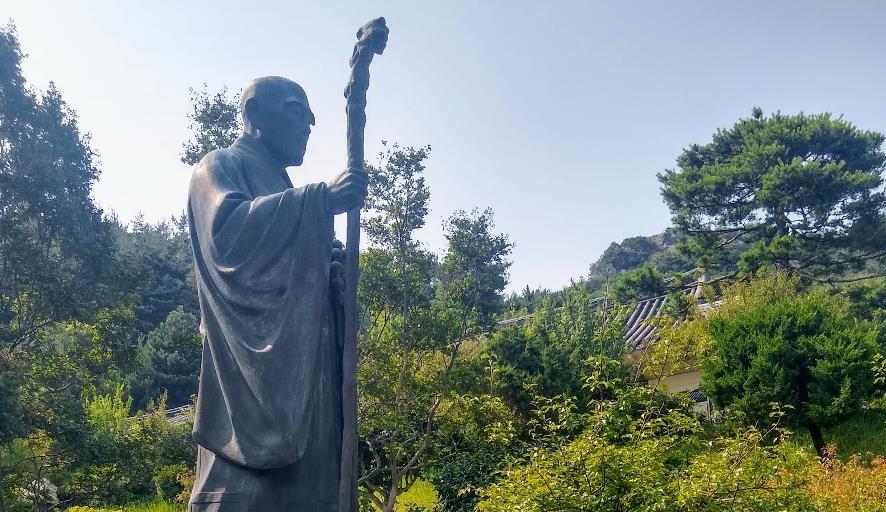
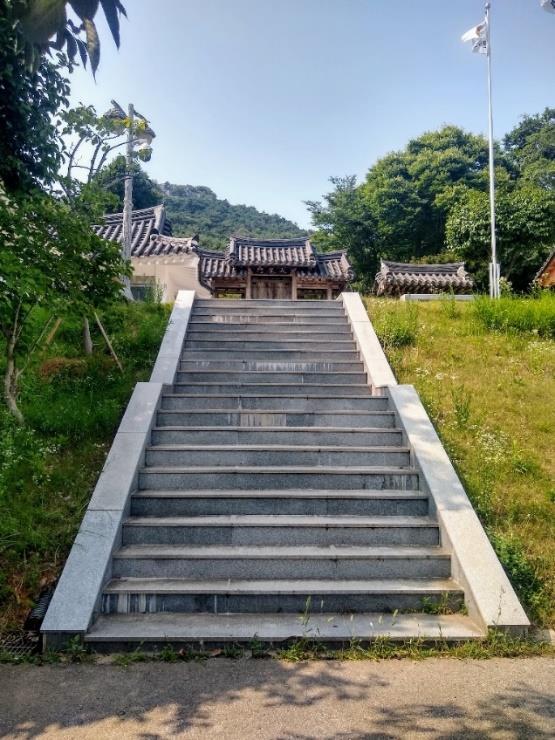
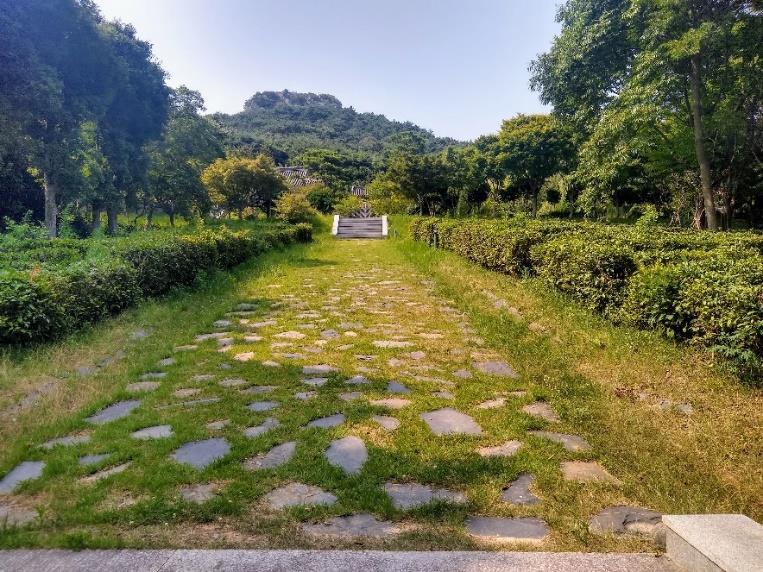
(Left) The Choui Seonsa Historic Site, which includes the poet’s birthplace, stands on a gentle hill near South Korea’s west coast.
(Right) Tea plants grow on both sides of the path leading up to the higher ground of the historic site.
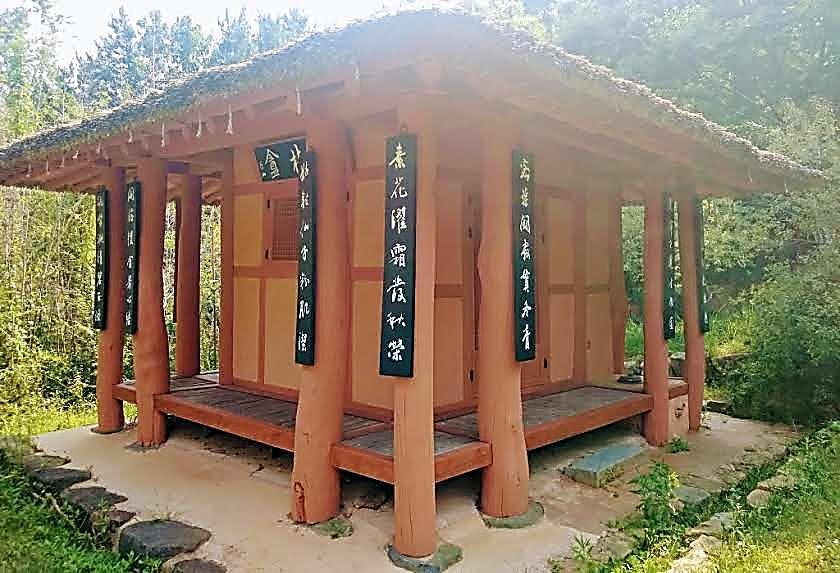

(Top) Choui built Iljiam (一枝庵, One Branch Hermitage) at Daeheungsa Temple in Haenam-gun, Jeollanam-do, and lived there from 1824 until his death in 1866. The hermitage became a center of tea culture during the late Joseon dynasty and a gathering place for poetry exchange. The structure in Muan is a replica of the original at Daeheungsa.
(Bottom) An artistic rendering of Iljiam, with Choui standing beside the hut.
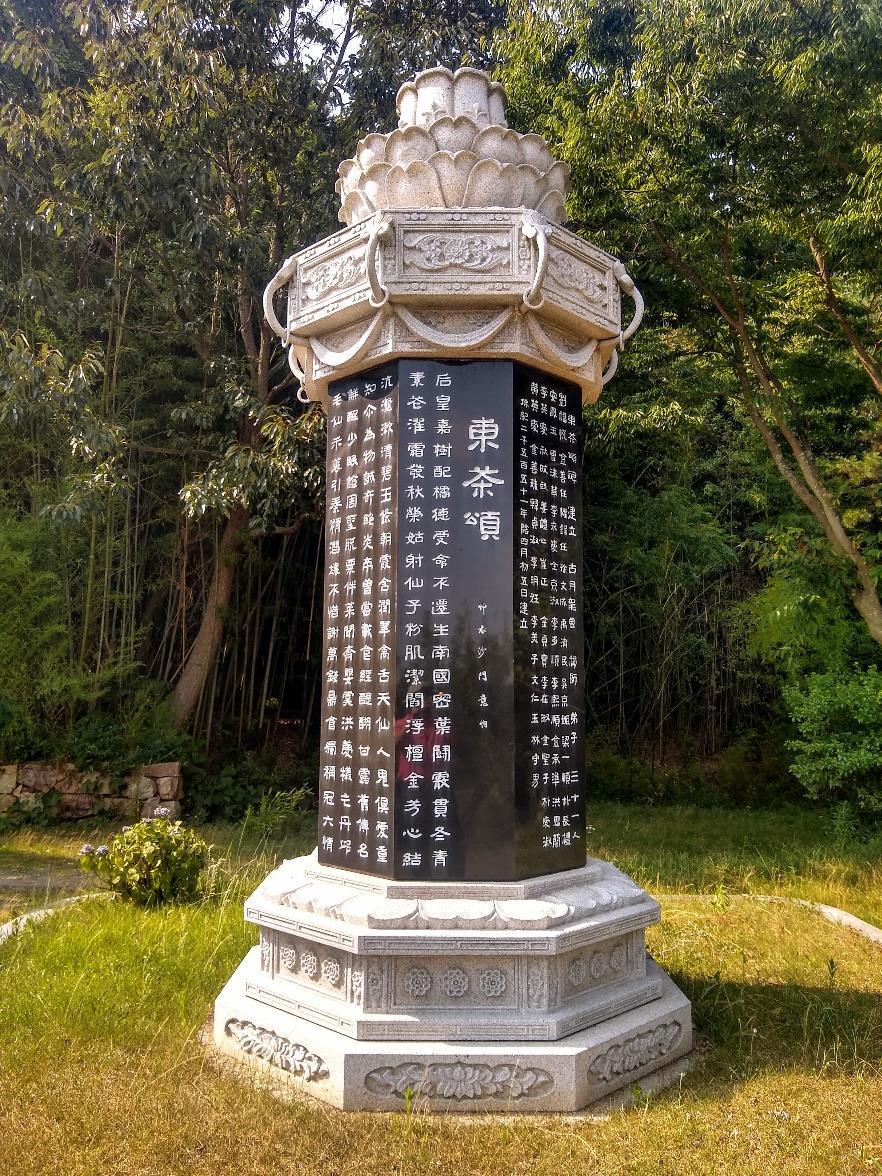
An excerpt from Choui’s Chinese-language book Dongdasong (東茶頌, Ode to Korean Tea) is inscribed on a stone monument.


The serene Choui Pond (草衣池, 초의지) lies within the grounds of the historic site, with its Chinese characters inscribed on a rock in the water.
Naju, the Birthplace of Sin Suk-ju (1417-1475)
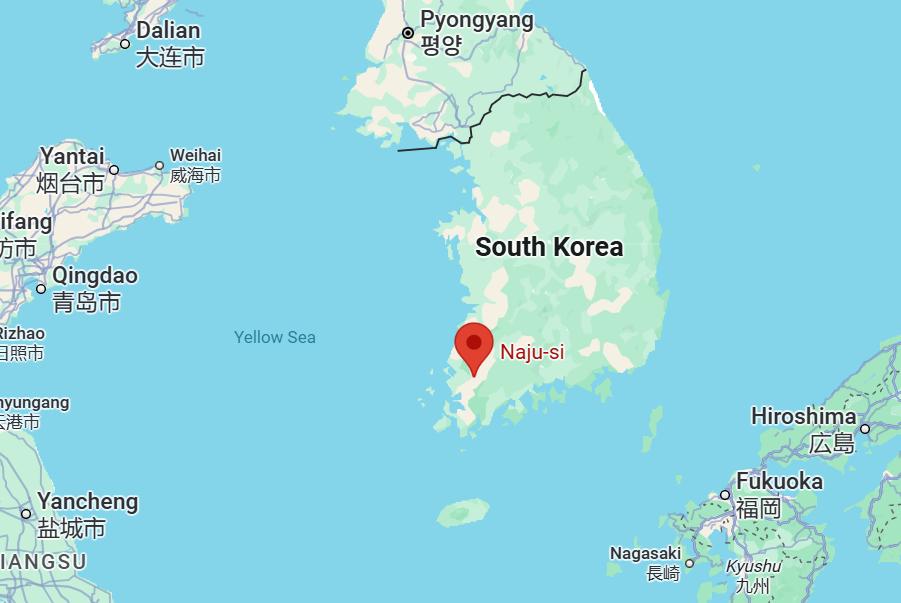
Sin Suk-ju (申叔舟) was born at Oryong-dong, Geuman-ri, Noan-myeon, Naju-gun, Jeolla-do (Jeolla Province) during the Joseon dynasty. The current address is Bansong Village, Geuman-ri, Noan-myeon, Naju-si, Jeollanam-do (South Jeolla Province). Credit: Google Maps.
Sin Suk-ju, a brilliant scholar-courtier of the Joseon dynasty, was born in Naju-si (Naju City) and excelled as a diplomat, translator, writer, and military strategist. Fluent in eight foreign languages, including Chinese, Japanese, and Arabic, he played a major role in Korea’s international relations. Despite his talents, his legacy is often associated with betrayal due to his support of King Sejo’s 1455 coup, after originally siding with the Sayuksin (Six Martyred Ministers). He later became Sejo’s closest confidant and earned fame for leading successful military campaigns against the Jurchens and Japanese.
The following Chinese poem was composed in mid-winter during the fifth year of King Sejo’s reign (1459), when the Jurchens launched a nighttime attack on a Korean garrison. Noticing the exhaustion of his troops, Sin Suk-
ju gathered his top generals, lay on the ground, and recited the poem aloud to help them relax and summon the courage to repel the enemy.
(Chinese)
阿赤河陣中
虜中霜落鐵衣寒
突騎橫行百里間
夜戰未休天欲曉
臥看星斗正闌干
(Korean translation)
아적하 진중에서
오랑캐 땅에 서리 내려 철 갑옷
기병은 백 리 벌판을 가로질러 달리네
밤새 싸움
누워서
(English translation) During Battle at the Achih River
Amid the foe, frost falls iron armor is cold. Raiding horsemen sweep across for leagues around. The night battle rages on until dawn nears. Lying down, I watch the stars drift overhead.
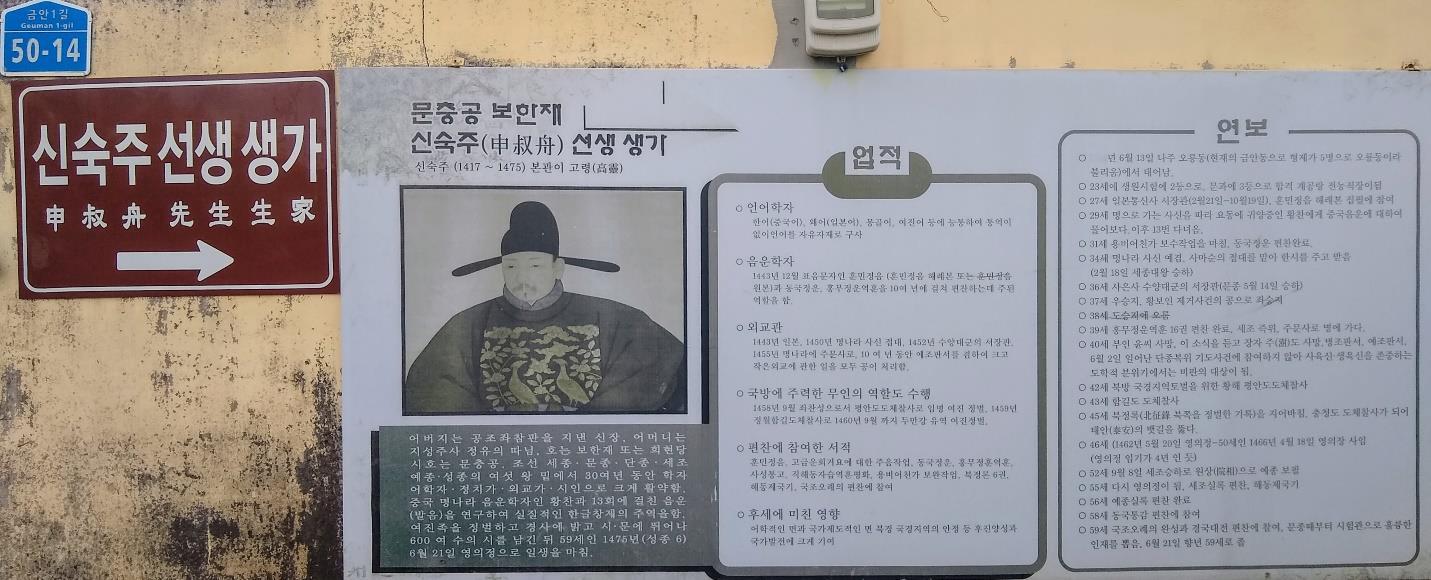
Perhaps due to his notoriety as a political betrayer, Sin Suk-ju’s birthplace in Naju is poorly maintained and remains difficult to find. Tucked away in a rural part of the city, it took me over thirty minutes to locate it in a small village. There were no signs along the way, and the one posted near the tightly shut main gate appeared worn and neglected. Alongside his portrait, the sign outlines Sin’s major accomplishments and provides a brief chronology of his life. As a top courtier, he served six kings, contributing his expertise in linguistics, phonology, diplomacy, and military strategy. He played a key role in the creation of Hangul, the Korean writing system, and left behind more than 600 poems.

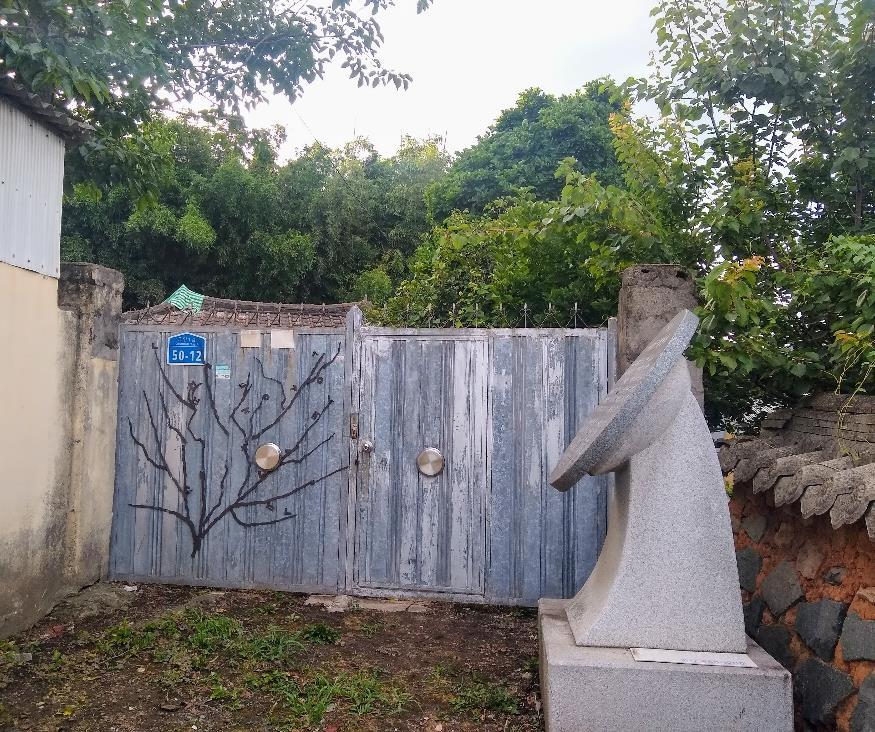

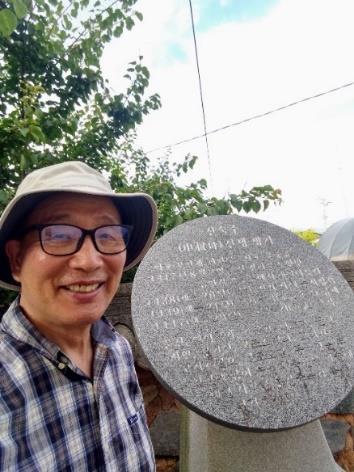
The gate is locked, and the stone monument in front of it is difficult to read. At the base of the monument, a sign reads, “The former site of Master Sin Suk-ju’s birth home,” noting that the property is privately managed rather than government-maintained. The wording suggests that the house behind the gate is not the original residence where Sin once lived.

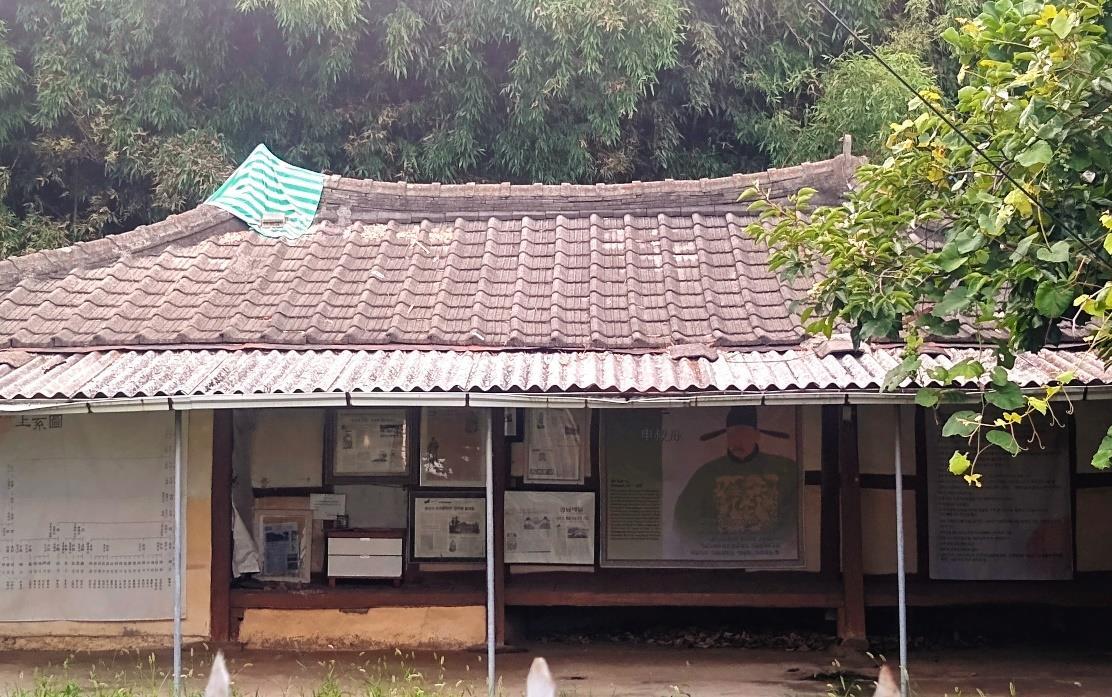
I managed to take pictures of the house beyond the gate by stepping onto the base of the stone monument. The house is in disrepair, though its front displays Sin’s portrait along with written records about his life. Given his monumental contributions to the kingdom and his brilliance in both scholarship and governance, historical judgments of his decision to side with King Sejo still seem unrelentingly harsh.

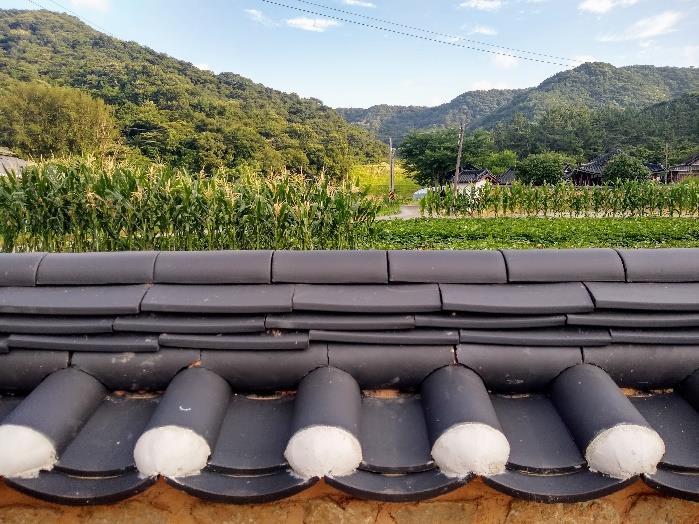
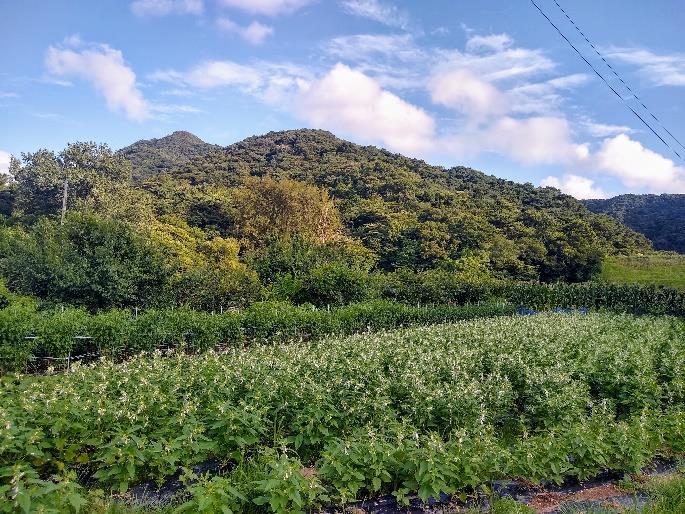
Woljeong Confucian School (now defunct) near Sin Suk-ju’s house seems to be preserved more meticulously. Typical of South Jeolla Province, the neighborhood is surrounded by low-lying mountains.
Seoul served as the capital of Korea during the Joseon dynasty (1392–1910) and the period of Japanese colonial rule (1910–45). Since the nation’s liberation in 1945, it has remained the capital of South Korea, while Pyongyang, another historic city, became the capital of North Korea. As South Korea’s political, economic, and cultural hub for centuries, Seoul is home to numerous literary landmarks. Some of these landmarks are found at Namsan Mountain Park in central Seoul.
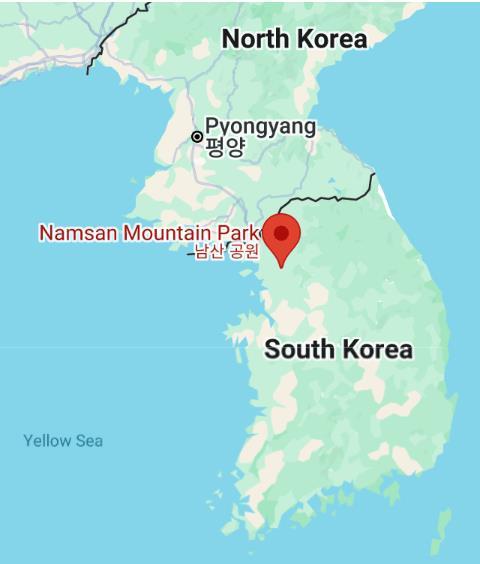
Namsan Mountain Park is located within walking distance of Seoul Station. Credit: Google Maps.
When I visited the park in December 2024, I encountered several poetry rocks honoring twentieth-century poets such as Kim So-wol (1902-34), Yang Ju-dong (1903-77), and Cheon Sang-byeong (1930-93). Before exploring their poems in Korean and English translation, we will look at several scenes from the park.

sign reads,
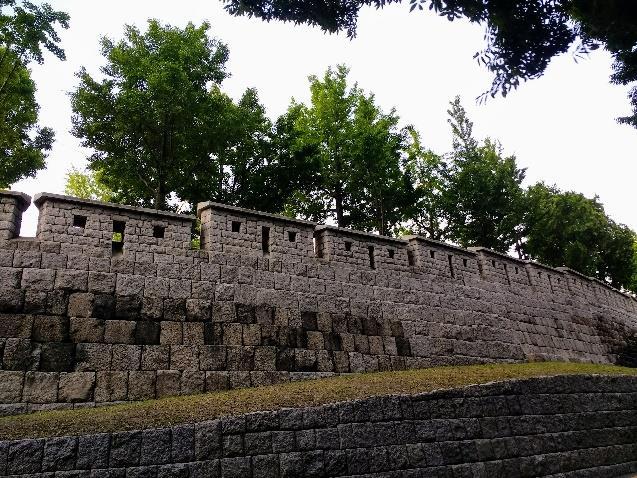

The Children’s Hall, which opened at Namsan Mountain Park in 1970, was relocated to Gwangjin Ward in 1974, and the original structure was transferred to the National Library of Korea.

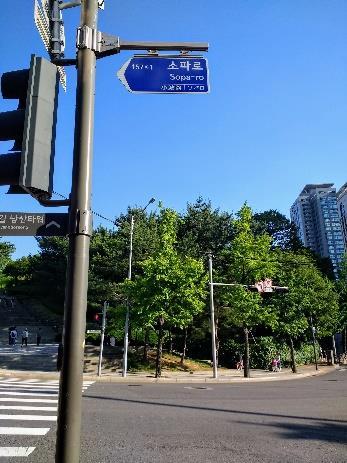
(Top) A street in Namsan Mountain Park is named for Kim So-wol, and one of his poems appears on the next three pages.
(Bottom) Another street, Sopa-ro, honors Bang Jeong-hwan (18991931), a pioneering writer of children’s literature who helped establish Children’s Day in Korea. Sopa was one of his pen names.
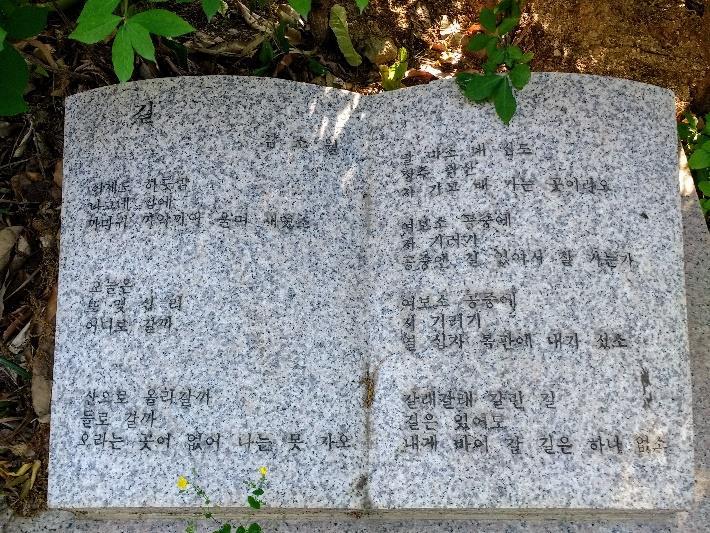
(Korean)
김소월 길
어제도 하로밤
나그네 집에
가마귀 가왁가왁 울며 새었소.
오늘은
또 몇 십 리(十里)
어디로 갈까.
산(山)으로 올라갈까.
들로 갈까.
오라는 곳이 없어 나는 못 가오.
말 마소, 내 집도
정주 곽산(定州郭山)
차(車) 가고 배 가는 곳이라오.
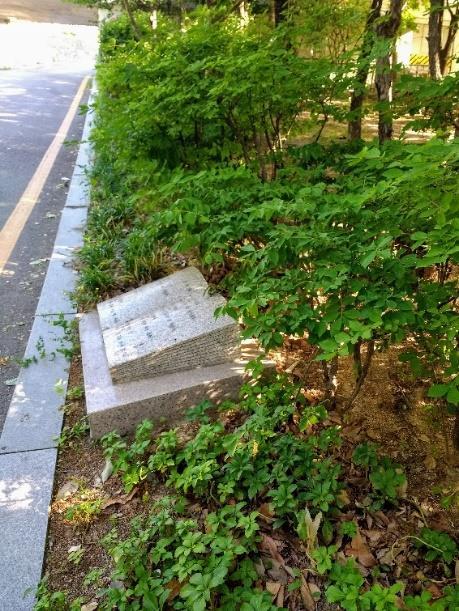
여보소, 공중에
저 기러기
공중엔 길 있어서 잘 가는가?
여보소, 공중에
저 기러기
열십자(十字) 복판에 내가 섰소.
갈래갈래 갈린 길
길이라도
내게 바이 갈 길은 하나 없소.
(English translation)
Kim So-wol
The Road
Last night, too, At a traveler’s inn, Crows cawed and cried until dawn.
Today,
Another few dozen ri, Where shall I go?
Shall I climb the mountains?
Shall I walk the fields?
With no place calling me, I cannot go.
Say no more my home Is Gwak-san, Jeongju, Where carts roll and boats set sail.
Tell me, up in the sky, You passing wild geese Do you find your way with a road in the air?
Tell me, up in the sky, You passing wild geese—
I stand at the very crossroads, lost.
Paths diverge in all directions, Yet among them all, There is not a single road for me.
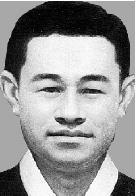
Portrait of Kim So-wol (public domain).
Kim So-wol, one of Korea’s most cherished modern poets, gained renown for crafting heartfelt poems shaped by the cadence of traditional Korean folk songs. His sole poetry collection, Azaleas (1925), stands as a pillar of Korean literature, with its title poem revered as his signature work taught in schools and memorized by students nationwide. Though his life was shadowed by hardship and ended too soon, his influence remains profound, securing his place among Korea’s ten most significant modern poets.
For further reading:
Kim, Sowol. Azaleas: A Book of Poems. Translated by David McCann, Weatherhead Books on Asia, Columbia University Press, 2007, 216 pages.
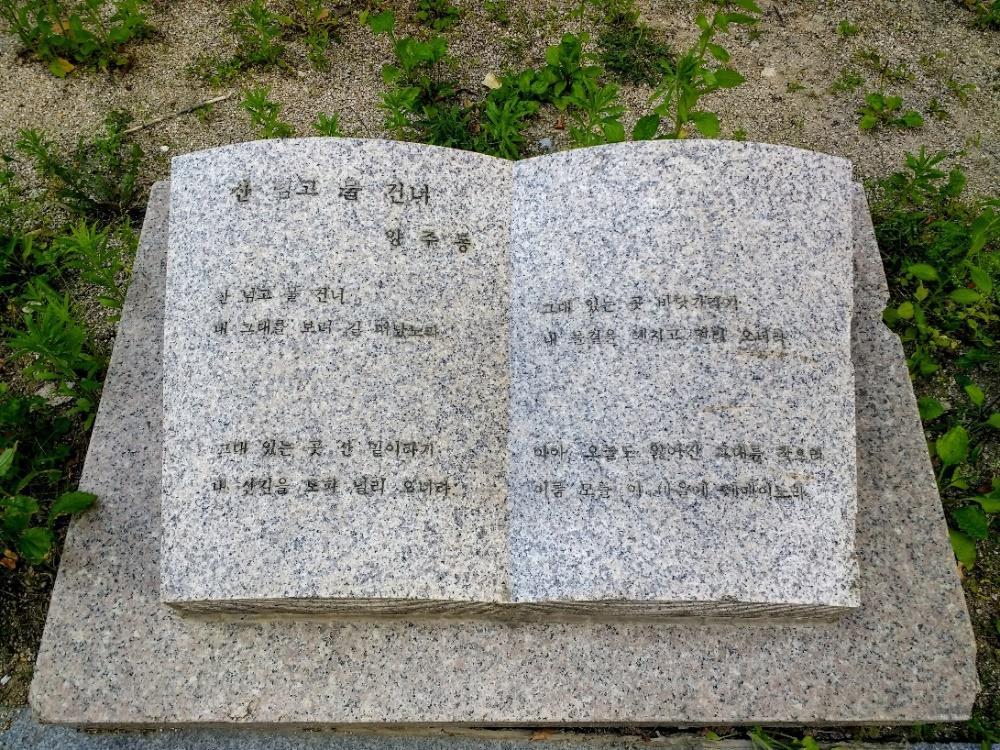
양주동
산 넘고 물 건너
산 넘고 물 건너
내 그대를 보려 길 떠났노라.
그대 있는 곳 산 밑이라기
내 산길을 토파 멀리 오노라.
그대 있는 곳 바닷가라기
내 물결을 헤치고 멀리 오노라.
아아 오늘도 잃어진 그대를 찾으려
이름 모를 이 마을에 헤매이노라
(English translation)
Yang Ju-dong
Over Mountains and Across Waters
Over mountains and across waters, I set out on the road to see you.
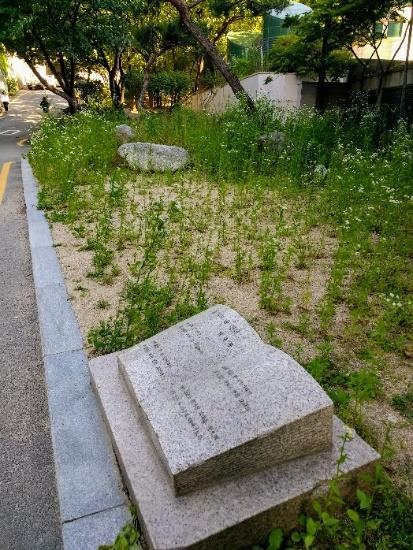
They say you live at the foot of the mountains, so I push through winding paths, coming from afar.
They say you live by the edge of the sea, so I part the waves, coming from afar.
Ah, once again today, in search of my lost love, I wander through this nameless village.
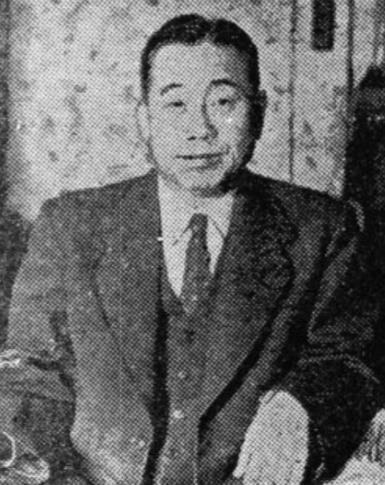
Photo of Yang Ju-dong (public domain).
Yang Ju-dong was a poet, professor, and literary scholar who played a pivotal role in advancing the study of both Korean and English literature. In his early years, he helped bring Western literary movements to Korea, later turning his focus to traditional Korean verse, particularly Hyangga and Goryeogayo.
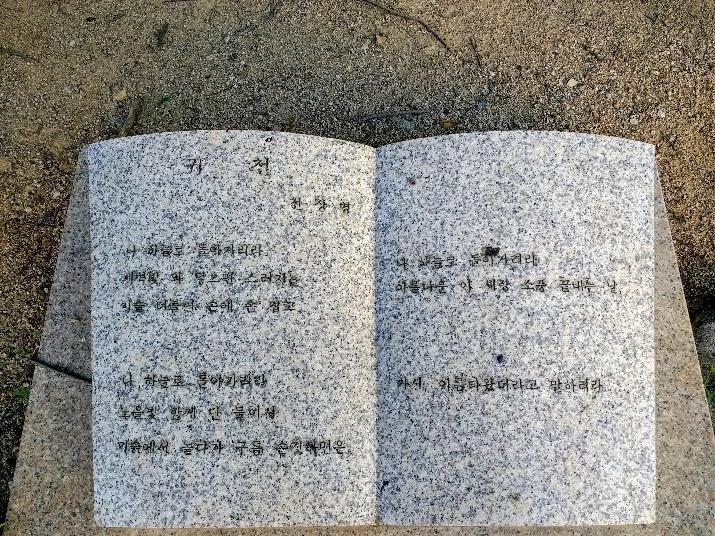
천상병 귀 천(歸天)
나 하늘로 돌아가리라
새벽빛 와 닿으면 스러지는
이슬 더불어 손에 손을 잡고
나 하늘로 돌아가리라
노을빛 함께 단 둘이서
기슭에서 놀다가 구름 손짓하면은
나 하늘로 돌아가리라
아름다운 이 세상 소풍 끝내는 날
가서, 아름다웠더라고 말하리라……
Cheon Sang-byeong
Returning to the Heavens
I will return to the heavens, When the dawn’s light touches me, Hand in hand with the fading dew.
I will return to the heavens, Playing with the sunset glow
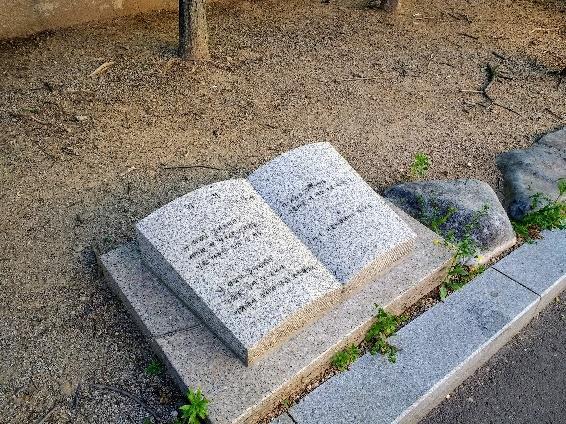
at the shore, when the clouds wave to us.
I will return to the heavens, On the day the beautiful picnic of this world ends, And say, “It was beautiful.”
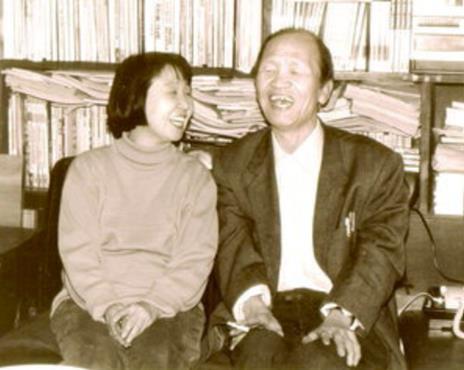
A joyful moment of the poet with his wife, Mok Soon-ok (1935-2010). Throughout their marriage (1972-93), Mok supported her unemployed husband by running a traditional tea house called Returning to the Heavens. Cheon had enrolled in Seoul National University’s Department of Economics in 1951 but later dropped out. In 1967, under the right-wing military dictatorship, he was arrested by the South Korean CIA on exaggerated charges of spying for North Korea in East Berlin, Germany. During his six-month imprisonment, he endured brutal torture, including electrocution, which left lasting physical and mental scars. The couple now rests together at Euijeongbu Park Cemetery in Euijeongbu, Gyeonggi Province.
Acrostic: A poem in which the first letter of each line forms a word or phrase when read vertically. A fine example is Edgar Allan Poe’s “Elizabeth” (c. 1829), a 16-line poem written for his cousin Elizabeth Rebecca Herring. The first letters of the respective lines are E, L, I, Z, A, B, E, T, H, R, E, B, E C, C, and A.
Boketto: A Japanese-style poem consisting of two stanzas. The first stanza contains five lines with a syllabic pattern of 7-7-7-4-5 (30 syllables in total). The second stanza is three lines with a syllabic pattern of 7-7-3 (17 syllables altogether). Variations of this form exist.
Cento: An original poem comprising lines borrowed from the works of other authors. After arranging the lines coherently, the poet identifies the source of each line. The cento is somewhat different from found poetry, which also uses outside texts.
Cheriga: A cherita combined with a simple visual art.
Cherita: A six-line narrative poem that usually consists of a single line, a couplet, and a tercet (3 lines). A cherita terbalik (inverted cherita) takes the form of 3–2–1, 2–1–3, 1–3–2, 2–3–1, or 3–1–2 lines. The cherita is an unrhymed, freestyle form and, similar to the tanka, is not titled.
Cinqku: A 17-syllable poem that has five lines of 2-3-4-6-2 syllables, respectively.
Cinquain: An unrhymed, five-line poetic poem that has a 2-4-6-8-2 syllable count. Some poets use iambic feet (an unaccented syllable followed by an accented one) in a cinquain. A related form is the didactic cinquain, which aims mainly to teach schoolchildren parts of speech. Below is the structure:
Line 1: a one-word noun (the subject of the poem)
Line 2: two adjectives that describe Line 1
Line 3: a three-word verbal phrase that further describes Line 1
Line 4: a four-word phrase that shows a feeling toward Line 1
Line 5: a one-word noun synonymous with or relate to Line 1.
The word cinquain is pronounced sing-kayne.
Clogynrach: A six-line Welsh poetic form with a syllable pattern of 8-8-55-3-3 and a rhyme scheme of aabbba.
Couplet: A two-line poem that has an end rhyme scheme and usually has the same meter for both lines.
Didactic cinquain: See Cinquain.
Ekphrastic poetry: Poetry inspired by visual art. Ekphrastic poems began in classical times as a tool for describing artwork. Ekphrastic poetry as written today is not merely a verbal representation of a visual art. Rather, it is a critical, subjective response to it. Regardless of the artist’s supposed intention, poets may come up with their own understanding of a work of visual art based on their life experiences, perspectives on life, and preoccupations. As in reader response literary criticism, ekphrastic poetry approaches the same work from different but equally valid angles.
Epitaph: An epigrammatic poem commemorating or epitomizing a dead person and short enough to fit a headstone. Epitaphs can be either serious or humorous. Humorous epitaphs, which are available as Google images, include “I Told You I Was Sick” and “Here Lies Clyde / His Life Was Full / Until He Tried to Milk a Bull.” Some poets and writers compose their epitaphs before their deaths. The word epitaph comes from the Greek word epitaphios (ἐπιτάφιος, “funeral oration”).
Etheree: The Etheree consists of ten unrhymed lines of 1-2-3-4-5-6-7-8-910 syllables. Etheree can also be reversed and written 10-9-8-7-6-5-4-3-2-1. It is attributed to an American poet, Etheree Taylor Armstrong of Arkansas. The Etheree is a highly flexible poetry form and lends itself to the writer's creativity. An Etheree should focus on one idea or subject. Double Etheree is two Etherees that make up one poem; the syllable count is 1-23-4-5-6-7-8-9-10-10-9-8-7-6-5-4-3-2-1.
Fibonacci (or Fib): A math-based poem that follows the Fibonacci sequence (1, 1, 2, 3, 5, 8, 13, etc.); most fib poems today are written in six lines of 1, 1, 2, 3, 5, and 8 syllables each. It can also be written in reverse order: 8, 5, 3, 2, 1, and 1.
Found poetry: A type of poetry that creates something new and meaningful out of borrowed texts. Unlike the cento, it does not list the sources used.
Free verse: A poem written without meter or an external rhyme. Many free verse poems, however, use internal rhymes and other rhythmic devices.
Gembun: A poetic form created by ai li in 1997. The gembun (pronounced gem boon) consists of either a one-word first link or anything up to one sentence, to be capped by a haiku of up to four lines. A gembun poem must include an element of suggestion in the opening sentence, in the haiku, or both.
Haiku: A Japanese poetic form from the 17th century, the haiku portrays the beauty and wonders of nature and human emotions as reflected in nature. It used to be written in a 5-7-5 syllable structure, but nowadays, it generally consists of three short lines in which the poet uses up to 17 syllables altogether. The plural of haiku is haiku, not haikus.
Haiga: A haiku combined with simple visual art (traditionally brush painting but currently any type of painting, drawing, or photography). A photo haiga is sometimes called a photoku.
Haibun (“haiku writings”): A form that combines prose and haiku. Instead of being a mere summary of the prose, the haiku must be fresh and insightful enough to stand alone as a poem. Among the best-known haibun writers is Matsuo Bashō (1644-94), who wrote the travelogue Oku no Hosomichi (Narrow Road to the Interior).
Imayo: A Japanese poetic form consisting of four lines, each with 12 syllables. A caesura (pause) separates the first seven syllables from the final five syllables in each line.
Joseph’s Star: An eight-line poem consists of 1-3-5-7-7-5-3-1 syllables each and is generally center-aligned. It can have either a single stanza or a set of stanzas.
Jueju (Chinese quatrain): A Chinese poetic type that flourished in the Tang Dynasty (618-907), it was used by the literati not only in China but
also those in Korea, Japan, and Vietnam for thousands of years. A jueju poem consists of couplets, each of which has either five characters (wujue) or seven characters (qijue).
Kyoka (“mad poem”) is to tanka what senryu is to haiku. Kyoka is identical to tanka in form but is comic and parodic in tone. Contemporary tanka and kyoka are written in free style, without exceeding 31 syllables altogether.
Lanterne (also spelled lanturne): A five-line poem that uses 1-2-3-4-1 syllables in five respective lines. Rhyming is optional, and a title may or may not be used in a lanterne.
Limerick: A nonsense poem based on wordplay. It usually consists of five lines and has the end rhyme scheme of a-a-b-b-a. The first line typically includes a person and a place name. Some limericks have the syllabic pattern of 8-8-5-5-8. Other patterns include 8-8-6-6-8 and 9-9-6-6-9. An 8-8-6-6-8 limerick follows the stress pattern of da DUM da da DUM da da DUM da DUM da da DUM da da DUM da DUM da da DUM da DUM da da DUM da DUM da da DUM da da DUM.
The first line usually serves as the title of a limerick.
Loop poem: A four-line, titled poem in which the last word of the first line becomes the first word of line two, the last word of line 2 becomes the first word of line 3, and the last word of line 3 becomes the first word of line 4. The rhyme scheme is a-b-c-b. A loop poem can have either a single stanza or a set of stanzas, and there are no restrictions on the number of syllables for each line.
Lune: An American-style haiku that has three lines of 5-3-5 syllables, respectively.
Nonet: A titled poem consisting of nine lines of 9-8-7-6-5-4-3-2-1 syllables, respectively. Rhyming is optional.
Octave: An 8-line poem with various rhyme schemes, including
Octave: An eight-line stanza or section of a poem. It can follow various rhyme schemes, such as a-b-a-b-a-b-c-c, a-b-a-b-c-c-d-d, a-a-b-b-c-c-d-d, or the classic a-b-b-a-a-b-b-a (common in Petrarchan sonnets). Octaves may function as standalone poems or as part of larger poetic structures.
Photoku: See Haiga.
Pirouette: A 10-line poem without meter or rhyme. In addition to having six syllables in each line, lines 5 and 6 have the same words and, combined, constitute a turnaround.
Quatrain: A four-line stanza or complete poem that rhymes. There are more than a dozen possible rhyme schemes, including a-b-a-c and a-b-c-b. A quatrain usually has a regular rhythm to the lines. Samuel Taylor Coleridge’s The Rime of the Ancient Mariner is a well-known ballad quatrain. The second stanza of the poem reads,
The Bridegroom’s doors are opened wide, And I am next of kin; The guests are met, the feast is set: May’st hear the merry din.”
Here, the rhyme scheme is a-b-c-b, and iambic tetrameter (an 8-syllable line) alternates with iambic trimer (a six-syllable line).
Rengay: A six-verse sequence of collaborative poems in which three-line and two-line haiku alternate. Composed by two or more poets, a rengay has a controlling theme.
Renku: A linked-verse poem in the haikai style, typically composed by two or more poets, in which verses are connected (linked) and shifted in topic, tone, or season. In Japanese, renku is the modern equivalent of haikai no renga, and it often alternates between three-line and two-line stanzas, producing a gentle long-short rhythm that echoes the original Japanese verse structure. Typical renku can be quite long eighteen (han-kasen), thirty-six (kasen), or more stanzas but shorter forms have become popular, including the twelve-verse junichō, which is highly flexible and
allows for creative variation in stanza arrangement, themes, and seasonal progression.
Rondeau: A medieval French poetic form that consists of a rhyming quintet (a five-line stanza), quatrain (a four-line stanza), and sestet (a sixline stanza). Altogether, a rondeau poem has 15 lines, each of which contains 8-10 syllables. The rhyme scheme is AABBA AABR AABBAR. (“R” represents the refrain.) The plural form of rondeau is rondeaux.
Sedoka: An ancient Japanese poetic form that consists of two three-line katauta (5-7-7, 5-7-7 syllables, respectively). The two sets of the 5-7-7 katauta constitute a conversation in Japanese sedoka. (The 5-7-5 katauta constitutes the first three lines of a traditional tanka.) The Manyoshu (“Collection of Ten Thousand Leaves”), an anthology compiled around 759, includes 62 sedoka poems.
Senryu: A three-line unrhymed Japanese poetic form structurally similar to the haiku but dealing satirically and humorously with human foibles. It arose as part of Edo (Tokyo) culture in the eighteenth century.
Septolet: A seven-line, 14-word poem that consists of three lines, a line break, and four lines.
Shape poem: A poem in which the lines are arranged in a way that represents the subject of the poem. It is also called a visual poem or concrete poem.
Sijo: A vernacular Korean poetic form whose basic structure requires approximately forty-five Korean characters (syllabic blocks) arranged in three unrhymed lines. Similar to contemporary haiku and other Japanesestyle short-form poems, Korean sijo are now written in freestyle.
Somonka: An ancient Japanese poetic form consisting of two love tanka, each representing one of the two respective lovers. A somonka can be written by two poets or by a single poet who adopts two voices. Below is John J. Han’s somonka that appeared in Elder Mountain: A Journal of Ozarks Studies, 9 (2019), p. 85:
Hollow, Fayetteville, AR
how much I desired an embrace in your strong arms that cold wedding night the fire that caught my dress, alas, reduced me to char
how much I miss you! at night people run away when they hear you scream come and scream at me, my love, for not saving you in time
Note: This poem is based on the legend of a young bride who was burned to death on her wedding night. The story can be found in Ozark Tales and Superstitions (by Phillip W. Steele, Pelican, 2003), “Arkansas History’s Mysteries—Ghost Hollow” (http://arkansasstatearchives.blogspot.com/2015/10/arkansashistorys-mysteries-ghost-hollow.html), and other sources.
Sonnet: A 14-line poem with a variable rhyme scheme originating in Italy and brought to England by Sir Thomas Wyatt and Henry Howard, earl of Surrey, in the 16th century. Traditionally, the sonnet (a “little song”) reflects upon a single sentiment, with a clarification or “turn” of thought (volta) in its concluding lines.
The Petrarchan (Italian) sonnet, perfected by the Italian poet Petrarch, divides the 14 lines into two sections: an eight-line stanza (octave) rhyming ABBAABBA, and a six-line stanza (sestet) rhyming CDCDCD or CDEEDE. John Milton’s “When I Consider How my Light Is Spent” and Elizabeth Barrett Browning’s “How Do I Love Thee” employ this form.
The Shakespearean (English) Sonnet: A sonnet with 14 lines consisting of three quatrains and a couplet, with a rhyme scheme of ABAB CDCD EFEF GG. George Herbert’s “Love (II),” Claude McKay’s “America,” and Molly Peacock’s “Altruism” are Shakespearean sonnets.
Most sonnets are about love and romance, and the tone of a sonnet can be either serious or humorous.
The Split Sequence: A twelve-line linked haiku form, plus title, written solo or collaboratively. A sequence is started by the poet splitting the 3-line haiku into 3 separate lines. Next, the poet writes a haiku for each line –first, second, and third, making it a 1-3-1-3-1-3 format. If it is a collaborative sequence, each poet alternates in writing the haiku. This form was invented by Peter Jastermsky in 2017. (Definition by Christine L. Villa, 5 March 2022)
Strombotto Tuscano: An eight-line Italian poetic form characterized by an ABABABCC rhyme scheme, where the first six lines alternate rhymes followed by a rhymed couplet. Each line contains 10 syllables, adhering to iambic pentameter, which comprises five metrical feet with an unstressed syllable followed by a stressed syllable.
Tan-Renga (“short linked verse”): A collaborative tanka written by two poets. Typically, one poet composes three lines, and the other poet adds two lines. A solo tan-renga, written by a single poet, leaves a blank line space between the first three lines and the two capping lines to distinguish the poem from a tanka.
Tanka: An aristocratic poetic form from ancient Japan, it is popular in both Japan and the English-speaking world. The traditional tanka consists of five lines of 5-7-5-7-7 syllables, respectively; the most common themes of traditional tanka are love (especially unrequited love) and nature. Most contemporary English-language tanka poets tend to use five short lines of various syllable counts without exceeding 31 syllables altogether.
Tanka art: Illustrated tanka. It is akin to a haiga except that it generally has five short lines.
Tanka prose: A form that combines prose and tanka. Instead of being a mere summary of the prose, the tanka must be fresh and insightful enough to stand alone as a poem.
Terce: A three-line poem in which the lines can vary in length. A tercet may follow a specific meter and rhyme scheme or be written in free verse.
Triptych: A poem of three stanzas, the second of which tends to be longer than stanzas 1 and 3. In visual art, a triptych (“three-fold”) means a three-
sectioned painting or carving. Similar to the three panels that constitute a thematic whole, the three stanzas in a triptych poem should work together to create a theme.
J.J.H.
James Aitchison is an Australian author and poet. At age 81, he has discovered the beauty of haiku and spends many hours experimenting with this wonderful form. His poetry has been published in The Australian Poetry Anthology, Quadrant, Aesthetica, Adelaide Literary, Everscribe, and many other journals. His children's poetry is regularly featured on the Australian Children's Poetry website and his own website, www.childrenspoetry.com.
Omarion Anderson is a native of Greenwood, Mississippi, and a beginning haiku poet eager to learn more about the form.
Hifsa Ashraf is an award-winning multilingual poet, author, editor, and social activist from Rawalpindi, Pakistan. She is the author of six individual and four collaborative micropoetry books. Please visit her blog to view her published work hifsays.blogspot.com or follow her on social media at @hifsays.
Joanna Ashwell is a writer from the UK. Her published collections of poetry include a collection of contemporary poetry (Flarestack Publishing), one haiku collection (Hub Editions), one tanka collection (Every Star, available on Amazon), and three Cherita collections (River Lanterns, Moonset Song, and Love’s Scriptures all available on Amazon). She has won several awards in competitions and has been on the Touchstone Shortlist for individual haiku and the Touchstone Longlist for haibun. Her short-form poetry haiku, tanka, haibun, and Cherita appears widely in both print and online journals. She is on the selection team for the Canadian tanka journal Gusts.
Jane Beal is Professor of English Literature at the University of La Verne in Southern California. She holds a BA, MA, and PhD in English from the University of California, Davis, and an MFA in Creative Writing. Beal regularly publishes poetry, fiction, and creative nonfiction. Her poetry collections include Sanctuary, Rising, and Song of the Selkie, along with eight haiku micro-chaps. She has also produced three audio projects combining poetry and music: Songs from the Secret Life, Love Song, and The Jazz Bird (co-created with her brother, saxophonist and composer Andrew Beal).
Boryana Boteva lives in Sofia, Bulgaria. She graduated from the University of National and World Economy in Sofia with a degree in International Economic Relations. In 2025, she received honorable mentions in two contests organized by the Bulgarian Haiku Society, as well as in the Third National Contest "The Cherry Waters of the Bulgarian Tanka." Internationally, she was awarded first place in the 2025 Japan Fair Haiku Contest and was a Runner-Up in the 2025 International "Vladimir Devide" Haiku Award. Her work has been published in several Englishlanguage platforms, including The Wee Sparrow Poetry Press, HaikUniverse, Under the Basho, Cold Moon Journal, Asahi Shimbun, and others.
Laila Brahmbhatt is a writer with roots in Kashmir and Jharkhand, India, who currently lives and works in New York as a senior consultant. Coming from a literary family where both her siblings are internationally acclaimed writers, she often feels like the black sheep and tends to be modest about discussing her own work a humility ingrained in her while growing up. She is currently immersing herself in learning Korean, Polish, and Japanese, drawn by her deep admiration for the poetry and literary traditions of these cultures.
Dr. Randy Brooks is Professor of English Emeritus at Millikin University in Decatur, Illinois, where he teaches courses on haiku, tanka, and Japanese poetics. He and his wife, Shirley Brooks, are publishers of Brooks Books and co-editors of Mayfly haiku magazine. His most recent books include Walking the Fence: Selected Tanka and The Art of Reading and Writing Haiku: A Reader Response Approach.
Pitt Büerken is retired and lives with his wife in Münster, the City of the Westphalian Peace (1648). He writes short stories and poems, especially haiku/senryu, tanka/kyoka, haibun, and tanka prose. His recent works also include cherita, dua, and gembun. In addition to numerous publications in international journals, he has published two haiku/senryu books: federleicht – feather light (ISBN 978-3-943292-65-7) and Pättkesfahrt (ISBN 978-3-89688-716-0). He enjoys biking with his wife in the countryside.
susan burch is a writer of short Japanese forms. She is the former Vice President of the Tanka Society of America and writes mostly from the
comfort of her couch. When not writing, she likes to read, do jigsaw puzzles, watch TV, and listen to music. She loves coca cola ices and birdwatching. If you ask her, she will send you her terrible pictures of the birds that come to her yard. Frequent visitors are crows, bluejays, mockingbirds, robins, finches, sparrows, hummingbirds, and woodpeckers. Occasionally she sees hawks, wrens, bluebirds, nuthatches, chickadees, cardinals, robins, grackles, cowbirds, starlings, and tufted titmice.
Oana Maria Cercel writes poetry, takes photos, and is co-editor of Cold Moon Journal, https://coldmoonjournal.blogspot.com/.
Timothy Daly is a wanderer who recently found a home. He writes, researches, and teaches. He co-edits Cold Moon Journal, https://coldmoonjournal.blogspot.com/.
Maya Daneva is a Bulgarian-born Canadian and a computer scientist at a Dutch university. Her haiku have been published in more than 20 journals worldwide, including Blithe Spirit, Hedgerow, Acorn, Haiku Presence, Canada Haiku Review, Frogpond, NOON, Tiny Words, Prune Juice, Time Haiku, and Wales Haiku Journal. Her haiku and senryu have also been featured in anthologies such as Jar of Rain: The Red Moon Anthology of English-Language Haiku 2020, Red Moon Press’s Annual Best of EnglishLanguage Haiku, and Shining Winds.
Amitava Dasgupta has been writing poetry since childhood, but for the past 30 years, he has focused primarily on haiku. His work has been published in Frogpond, Modern Haiku, and other literary magazines. He has received several poetry awards, including the Penumbra Poetry and Haiku Contest organized by the Tallahassee Writers Association and recognition from the New Zealand Poetry Society, among others. By day, he is a Professor of Pathology and Laboratory Medicine at the University of Kansas School of Medicine in Kansas City, KS. He lives in Lenexa, KS, with his wife, Alice, and their two cats.
thomas david is from West Sussex in the United Kingdom. His haiku and senryū have been published in Failed Haiku, tsuri-dōrō, The Wales Haiku Journal, Cattails, and The Heron’s Nest.
Melissa Dennison is a haiku poet and writer of Japanese short forms. Her work is inspired by her everyday lived experience and observations of nature and the creatures that share her world.
Elliot Diamond is a retired doctor/acupuncturist, with most of his past acupuncture training from the “Blind Acupuncture Association of Japan.” After years of studying Japanese acupuncture, his haiku/haiga expression began. Other passions and joys include being a musician, focusing on ethnographic and avant-garde jazz compositions. There is true joy in boiling down the essence of thought and feeling to a haiku poem and then possibly merging it with visuals steeped in nature and the imagination.
John H. Dromey was born in northeast Missouri. Years ago, he contributed light verse and brief, humorous items to magazines, newspapers, and trade journals. His flash fiction and short stories have appeared in over two-hundred venues, including numerous anthologies. Recently, he’s had speculative poetry published in Scifaikuest (print and online), Eye to the Telescope, Star*Line, The Lorelei Signal, Lothlorien Poetry Journal, View from Atlantis, the Dwarf Stars 2022 anthology, and elsewhere.
John J. Dunphy’s collections of haiku and haiku-related poetry include Old Soldiers Fading Away; Stellar Possibilities; Zen Koanhead: A Senryu Collection; Touching Each Tree; Dark Nebulae; Pagan Rites; and Bullet Cluster. Dunphy’s work has been selected for the Red Moon anthologies and several topical anthologies edited by Stanford M. Forrester and Robert Epstein. One of his poems was nominated for a Pushcart Prize in 2016.
Keith Evetts is a retired British diplomat. His publications include scientific papers, history articles, long-form poetry, and approximately a thousand haiku and related short forms in various journals. His work has been nominated for the Pushcart Prize and the Touchstone Awards and has been anthologized in Red Moon, Contemporary Haibun, Modern Haiku, and Dwarf Stars. Evetts is an administrator of Facebook’s largest haiku group, managing editor of the haiku commentary feature at The Haiku Foundation, and one of ten editors worldwide of the annual Red Moon Anthology.
Colleen M. Farrelly is a mathematician and hybrid poet living in Miami, FL, whose haibun and other hybrids have appeared in Modern Haiku,
Frogpond, dadakuku, Failed Haiku, MacQueen's Quinterly, Wales Haiku, #femkumag, The MacGuffin, drifting sands haibun, cho, Haibun Today, Chrysanthemum, Presence, The Haibun Journal, Open: Journal of Arts & Letters, Leading Edge, scifaikuest, and many others. She has published two mathematics textbooks (The Shape of Data and Modern Graph Theory Algorithms with Python) and spends her time working on topological data analysis, geometric deep learning, and dynamic systems research. She serves as a mentor for African data science initiatives.
Ben Gaa is your friendly neighborhood haiku poet and host of Haiku Talk on YouTube. He’s the author of two full-length collections of haiku & senryu, One Breath (Spartan Press 2020) and the Touchstone Awardwinning Wishbones (Folded Word 2018), as well as three chapbooks, the Pushcart nominated Wasp Shadows (Folded Word 2014), Blowing on a Hot Soup Spoon (Poor Metaphor Design 2014), and Fiddle in the Floorboards (Yavanika Press 2018). With over 1,000 haiku and senryu published in journals and anthologies around the globe, he enjoys both giving and attending poetry readings, conducting haiku workshops, and being a part of the literary conversation. Learn more about Ben at www.Ben-Gaa.com.
Goran Gatalica was born in Virovitica, Croatia, in 1982 and currently resides in Zagreb, Croatia. He completed degrees in both physics and chemistry at the University of Zagreb and proceeded directly to a PhD program after graduation. He has published poetry, haiku, and prose in literary journals and anthologies. Gatalica has received many honors for his poetry and haiku, including the Dragutin Tadijanović Award from the Croatian Academy of Sciences and Arts for the poetry book Kozmolom (2017); the honor “Haiku Master of the Month” (Rikugien Gardens and Biei, NHK WORLD TV, Japan, 2016 and 2017); and the Basho-an Award (Japan, 2018, 2019, and 2023). He is a member of the Croatian Writers' Association.
Mark Gilbert is based in the UK and enjoys writing short prose and poetry (including hybrid forms). His work regularly appears in online and print journals and anthologies, and his haiku have won the Trailblazer Contest, a Touchstone Award for Individual Poem, and the Polish International Haiku Competition. He is the author of Ribbons & Rainbows (Yavanika Press, 2021), Nano Haiku (Origami Poems Project,
2022), and Variations on the Planets, an astronomical poetry chapbook cowritten with Eavonka Ettinger (Nun Prophet Press/Amazon, 2025).
David Green has had haiku published in Modern Haiku, Frogpond, The Heron’s Nest, Mayfly, confluence, and other journals. One of his senryu won third place in the Haiku Society of America’s Gerald Brady Senryu Awards. A haiku of his has been displayed in the Atlanta Botanical Gardens. Two of his poems were selected to be part of the Midwest Haiku Traveling Rock Garden. David is a teacher and poet in Chicago. He is also an associate editor of the online haiku journal confluence.
Violet Avery Hall is an avid reader, amateur surfer, and new poet from Jacksonville, Florida. She enjoys iced coffee, dogs of all breeds, and her job as a pool lifeguard. Violet’s work can be found in Haiku Girl Summer, Cold Moon Journal, Hedgerow, and Poetry Pea.
John J. Han, Ph.D., is Professor of English and Creative Writing and Associate Dean of the School of Humanities and Theology at Missouri Baptist University. He is the author, editor, co-editor, or translator of 35 books. Among his recent books are Certainty and Ambiguity in Global Mystery Fiction: Essays on the Moral Imagination (Bloomsbury Academic, 2024) and Passing Thoughts: Haiku, Senryu, and Other Poems (Cyberwit, 2024). Han has also published nearly 3,000 poems in journals and anthologies, such as Cave Region Review (featured poet of the year 2012), Failed Haiku, Frogpond, Modern Haiku, Simply Haiku (chosen as the world’s sixth-finest English-language haiku poet for 2011), Valley Voices (Pushcart-nominated), and Wales Haiku Journal (nominated for the Touchstone Award).
John Hawkhead is a writer and artist from the southwest of England. His work has been published globally over the last thirty years, including three books of haiku/senryu: Small Shadows (alba Publishing), Bone Moon (Alba Publishing), and Four Horse Parable (Nun Prophet Press). He has published more than 2000 short-form poems worldwide, winning numerous awards and competitions. He has been shortlisted four times for the Touchstone Award for individual poems. Bone Moon placed third in the 2023 Haiku Society of America Merit Book Awards and was also shortlisted for a Touchstone Award for individual collections.
Patricia Hawkhead’s haiku, senryu, kyōka, haiga, and poetry have appeared in a range of publications, including Akitsu Quarterly, Asahi Haikuist Network, Autumn Moon Haiku Journal, Bare Bones, Better than Starbucks, Blōō Outlier Journal, Bones Journal, Candelabrum, Cattails, Cold Moon Journal, dadakuku, Daily Haiga, Echidna Tracks, Failed Haiku, #femku mag, Five Fleas (itchy poetry), Haiga Online, Horror Senryu Journal, haikuNetra, The Haiku Universe, The Mainichi, Poetry Pea, Presence, Prune Juice Journal, Re-Side, Scarlett Dragonfly, Shadow Pond Journal, The Haiku Foundation, Trash Panda, tsuri-dōrō, Wales Haiku Journal, and 5-7-5 Haiku Journal.
Janet Ruth Heller, Ph.D., is the past president of the Michigan College English Association and the Society for the Study of Midwestern Literature. She has published four poetry books: Nature’s Olympics (Wipf and Stock, 2021), Exodus (WordTech, 2014), Folk Concert: Changing Times (Anaphora, 2012), and Traffic Stop (Finishing Line, 2011); a scholarly book, Coleridge, Lamb, Hazlitt, and the Reader of Drama (University of Missouri Press, 1990); a middle-grade fiction chapter book, The Passover Surprise (Fictive, 2015, 2016); and an award-winning fiction picture book about bullying, How the Moon Regained Her Shape (Arbordale, 2006; 7th edition 2022). Website: https://www.janetruthheller.com.
Juliet Hinton, ODS, BSB, MBA, is the Cancer Registry Manager in Research and Informatics at Forrest General Hospital, where she has served for over twenty-four years. A certified Oncology Data Specialist, she provides managerial and strategic planning services in cancer care. In January 2022, she received a Pushcart Prize nomination for her poem “Calvary Baptist Church,” published in Delta Poetry Review. Her poetry known for its metaphoric landscape vision, strong feminine voice, and exploration of the miseries and mercies of Perry County has appeared in Tipton Poetry Journal, Valley Voices Literary Review, Delta Poetry Review, San Pedro Review, and other literary journals. Her chapbook, The Mercies of Perry County, was published by Finishing Line Press in February 2024. She is currently working on additional Perry County and landscape poems, as well as a new writing project focused on oncology and cancer care.
Gary Hotham was the 2022–2023 Honorary Curator of the American Haiku Archives at California State University, Sacramento. He began
writing and publishing haiku in 1966, and since then, his haiku have appeared in numerous journals and anthologies. His first chapbook collection was published in 1976, and more than 20 chapbooks and larger collections have appeared since. His most recent collection, Our Backs to the Wind: Selected Haiku, was published by Brooks Books. He is currently serving as the first vice president of the Haiku Society of America.
Ann Howells was raised on Chesapeake Bay. In 1979, she moved to Texas, where she edited Illya’s Honey for eighteen years. Her recent books are So Long as We Speak Their Names (Kelsay Books, 2019), about Chesapeake Bay watermen, and Painting the Pinwheel Sky (Assure Press, 2020), persona poems in the voice of Van Gogh. Two chapbooks were published through contests: Black Crow in Flight, Editor’s Choice in Main Street Rag’s 2007 competition, and Softly Beating Wings, winner of the 2017 William D. Barney Award (Blackbead Books). Ann’s work appears in many small press and university journals.
Phillip Howerton has taught English at colleges in the Ozarks for more than twenty-five years. He is a co-founder of Cave Region Review, and his poetry, essays, and book reviews have appeared in numerous magazines and journals. Golden Antelope Press published his poetry collection The History of Tree Roots in 2015 and his Gods of Four Mile Creek in 2023. The University of Arkansas Press published his anthology, The Literature of the Ozarks, a project for which he received the 2019 Missouri Literary Award from the Missouri Library Association. He is also the publisher and/or editor of nine other books.
Terrie Jacks is a former president of the Missouri State Poetry Society. She graduated from the University of Missouri with a B.S. in Education. Having lived in several different states and spent several years in England, Jacks has had her poems published in Cantos, Fireflies’ Light, The Oasis Journal, Spare Mule, Grist, Cattails, Failed Haiku, Tanka Origins, and Galaxy of Verse. Some of her stories have appeared in The Right Words and Flash! For several years, she illustrated Korean folktales retold by John Han, which were published in the Korean-American Journal and later in the book Spousal Competition and Other Tales from Korea (2021) by Han. Jacks continues to write and illustrate poems and has occasionally entered them in local art exhibits.
Roberta Beach Jacobson (she/her) is drawn to the magic of words–poetry, song lyrics, flash fiction, puzzles, and stand-up comedy. Her latest book is Demitasse Fiction: One-Minute Reads for Busy People (Alien Buddha Press, 2023). She lives in Iowa, USA. https://linktr.ee/roberta_beach_jacobson
AJ Johnson is a Japanese-English translator and foreign affairs analyst. He has been writing haiku, senryu, and haibun for about four years. His work has recently appeared in Frogpond, Kingfisher Journal, tsuri-dōrō, cattails, Autumn Moon Haiku Journal, Mainichi Shimbun, Asahi Haikuist Network, and Haiku in Action. AJ lives in Northern Virginia with his wife and children.
Monica Kakkar (she/her/hers) values her freedom and peace and cherishes silence and solitude. She is grateful that haiku found her. Her haiku have been nominated for The Haiku Foundation's Touchstone Award for Individual Poems (2025), have won awards, reached final shortlists, been translated into three languages, and published on four continents. Her works have appeared on a cedar pole, window cling, and garden listed on the National Register of Historic Places; in libraries; on tear-off-strip flyers at poetry festivals; in galleries of viewing stones; and in anthologies, journals, magazines, newsletters, and booklets, among other venues. She enjoys location independence and has no social media presence except LinkedIn: https://www.linkedin.com/in/monicakakkar.
Keitha Keyes lives in Sydney, Australia, in a tiny house filled with antique irons and ship models. She enjoys writing tanka, kyoka, haiku, senryu, cherita and related genres. Her work is published in many journals and anthologies in Australia and overseas.
Dr. Miye Kim is Professor Emeritus in the Department of English Language and Literature at Dongduk Women’s University in Seoul, Korea. Until her retirement in 2020, she held various leadership roles at the university. Currently, she serves as editor and head judge for the haiku section of The Wild, a Korean literary magazine based in Seoul. Dr. Kim earned her Ph.D. in Shakespeare Studies from Korea University. Beyond her academic work, she is passionate about theater and has directed over ten Shakespearean productions.
Philip C. Kolin is the Distinguished Professor of English Emeritus at the University of Southern Mississippi. He has published more than 40 books, including 17 collections of poems, the two most recent being White Terror, Black Trauma: Resistance Poems about Black History (Third World Press, 2023) and Evangeliaries (Angelico Press, 2024).
Lavana Kray lives in Romania. Her work has appeared in many print and online publications, as well as in haiga exhibitions organized by the World Haiku Association in Japan and Italy. In 2015 this Association awarded her the title of Master Haiga Artist. Many of her photo-haiku have been featured in NHK Haiku Masters on Japanese TV. The Laval Literary Society from Canada awarded her the André-Jacob-Entrevous Prize 2023, for a literary text (haiku) combined with an artistic visual. She currently serves as haiga editor for Cattails, an online journal of Japanese short forms.
Nathaniel Lachenmeyer is an award-winning disabled author of books for children and adults. His first book, The Outsider, which takes as its subject his late father’s struggles with schizophrenia and homelessness, was published by Broadway Books. Nathaniel has forthcoming or recently published poems in The American Poetry Review, Poetry International Online, North Dakota Quarterly, Blue Unicorn, Red Rock Review, F(r)iction, Santa Clara Review, and DIAGRAM. Nathaniel lives outside Atlanta with his family. www.NathanielLachenmeyer.com.
Tiana Lešnik is an undergraduate English major at the University of Ljubljana, Slovenia. She began writing poems and songs in elementary school. Her early writing reflected personal struggles and emotions, so she kept it private, but she has recently started sharing her work. Music is an important part of her life, as she enjoys singing and listening to a wide range of genres. Growing up on a hill surrounded by forests, nature is a common theme in her writing. Animals are also dear to her, and she enjoys long walks and reading outdoors.
Chen-ou Liu lives in Ajax, Ontario, Canada. He is the author of five books, including Following the Moon to the Maple Land (First Prize, 2011 Haiku Pix Chapbook Contest) and A Life in Transition and Translation (Honorable Mention, 2014 Turtle Light Press Biennial Haiku Chapbook Competition). His tanka and haiku have been honored with many awards.
Anthony Lusardi lives in Rockaway Borough, New Jersey. While working with the night crew at a Costco store, he writes poetry to “share the moments” with others. His poems have been published in multiple journals, such as Frogpond, Modern Haiku, Bottle Rockets, Hedgerow, Ribbons, Prune Juice, Eucalypt, The Paterson Literary Review, Verse Virtual, and Dadakuku. Lusardi currently has four chapbooks (with a fifth on the way), published by Buddha Baby Press, which is based in Windsor, Connecticut. His latest text is Raindrops from Yesterday. To purchase copies, readers may contact him by email at lusardi133@gmail.com.
DS Maolalai has been described by one editor as “a cosmopolitan poet” and another as “prolific, bordering on incontinent.” His work has been nominated fourteen times for Best of the Net (BOTN), ten times for the Pushcart Prize, and once for the Forward Prize, and released in three collections: Love Is Breaking Plates in the Garden (Encircle Press, 2016), Sad Havoc Among the Birds (Turas Press, 2019), and Noble Rot (Turas Press, 2022).
Richard L. Matta is originally from New York’s Hudson Valley and now lives in San Diego, California. He has a background in forensic science, and in retirement enjoys spending time on the ocean sailing or cruising, walking botanical parks, and volunteering at Balboa Park theatre. He writes in many poetic forms, and in 2023, was a Pushcart nominee (long-form) and Touchstone Award nominee (haiku). Over the years, his poems have been honored in international contests, included in anthologies, and published in journals such as Healing Muse, New Verse News, Hole in the Head Review, Modern Haiku, The Heron’s Nest, Blithe Spirit, and others.
MarthaMaggie Miller is an Army veteran and environmental professional with a Bachelor of Arts degree who uses poetry as an outlet for emotions of all colors, combining words and musical elements to explore shared experiences. She published Heartfelt Snippets with Moments of Magic (2022) and has work published in Shadow of the Soul; The Endeavor: Maiden Voyage, Smooth Sailing, Stormy Weather, Making Waves, Helms Alee, Any Old Port Will Do, Anchors Aweigh, and Hoist the Colors; A Poetic Field Filled with Wildwood Flowers; Inscribed Reveries; Carnival of Sins; Shattered Reflections; Wheelsong 5/6; Invisible Poets 2/3; Cantos 30/31; and Fireflies’ Light 29/30/31.
Elizabeth L. Merrick’s poems have appeared or are forthcoming in journals including Stone Poetry Review, Rue Scribe, Amethyst Review, Green Hills Literary Lantern, Muddy River Poetry Review, and The Quasar Review. She has also authored scientific research publications and a guidebook on Boston’s historic house museums. She lives in Somerville, Massachusetts.
Mark J. Mitchell has worked in hospital kitchens, fast food, retail wine and spirits, conventions, tourism, and warehouses. He has also been a working poet for almost fifty years. His latest novel, A Book of Lost Songs, was recently published by Histria Books. An award-winning poet, Mitchell is the author of five full-length poetry collections and six chapbooks. His most recent collection is Something To Be (Pski’s Porch Publishing). He is fond of baseball, Louis Aragon, Miles Davis, Kafka, Dante, and his wife, activist Joan Juster. He lives in San Francisco, where he makes a marginal living pointing out pretty things.
Bert Molsom retired early to become an apprentice poet, understanding such apprenticeships never end! He lives in Ledbury, U.K., to save having to travel to the annual Poetry Festival. His work has appeared in Acumen, Anthropocene, Dust Poetry, Fenland Poetry Journal, Ink, Sweat & Tears, Orbis, Prole, Sarasvati, Seventh Quarry Press, and The Ekphrastic Review (USA). He finds/cinquains help him/concentrate, clarify/the direction of his writing/process.
Eva Novak is an undergraduate English major at the Faculty of Arts, University of Ljubljana, Slovenia. She finds comfort and passion in writing poems and songs. Novak has been writing prose since her early teens and began writing poetry in high school as an experiment. In 2019, during her final year of high school, she published her poetry collection Preden Odrastem (Before I Grow Up). Her poems focus on detailed description and the existential experience of the present moment. She often explores themes of detachment, mental health and illness, love, and generational trauma, and usually writes in her native language.
Gareth Nurden was born in Newport, Wales, in 1988 and has been writing poetry since his teenage years. In recent years, he has focused on writing Japanese poetry such as haiku, senryu, and haiga. Gareth has had the honour of having his pieces published in sixteen countries worldwide,
appearing in more than fifty journals, websites, and e-zines. Though he has yet to publish his first collection of poetry, he continues to write and publish his pieces through established journals. Alongside writing poetry, Gareth enjoys spending much of his spare time in nature and travelling, as well as practising photography.
David Oates is a writer and teacher. He’s the host and producer of Wordland, a radio program of poetry, stories, and comedy, and the former host of Great Apes (comedy), both on WUGA, public radio for Athens, GA. He ran the Athens poetry slam and was the editor and publisher of Monkey Magazine (mostly slam poetry and satire). He’s published four books of haiku: Shifting with My Sandwich Hand, Drunken Robins, The Deer’s Bandanna, and only thunder: a family journey. His poems have appeared in many journals. Oates wrote for the comic strip Shoe in the ’80s.
Ben Oliver lives in the Cotswolds, Gloucestershire, with his wife, Michelle, and two children, Aurelia and Linden. As a child, he grew up on (and in) the River Thames, where he developed a deep affinity with nature. Having studied biology at the University of Manchester, he works at Westonbirt National Arboretum, helping people engage with the majesty of trees. He has been fortunate to have had poems published in many haiku journals, including Frogpond, Heron’s Nest, Modern Haiku, Presence, Kingfisher, and Failed Haiku.
orha is the joy of a shadow. it is the heckling of the stars. it is a Nobody traversing the remnants of a familiar place. it seeks solace in the creatures of tradition. it finds only letters on a page. you can find its work in chrysanthemum, frogpond, kokako, and other planes of existence. orha was made possible by contributions to your PBS station from readers like you. thank you.
John Pappas is a poet and teacher whose haiku have earned numerous honors, including a Touchstone Award from The Haiku Foundation, a 2023 Trailblazer Award, a silver medal in the 2023 Ito En New Haiku Grand Prix, and multiple awards in the Vancouver Invitational and Heliosparrow Haiku Frontier Awards. His chapbook dimes of light was published in 2024 by Yavanika Press. His work appears in off the main road and New Resonance 14. Also a drummer and lyricist, John has toured with his punk band, Heather Hates You. He lives in Boston with his wife and two daughters.
Curt Pawlisch is a native of Madison, Wisconsin, who began reading and writing poetry in high school. In retirement from his legal career, he has returned to his “first love.” Influenced by a talk given by haiku master Lee Gurga, Pawlisch has never looked back. He has been published numerous times in various journals for his haiku, senryu, tanka, haibun, and haiga.
M. R. Pelletier lives in Kansas, but his haiku poetry travels the world. He has published in multiple journals, including Creatrix, Cold Moon Journal, Presence, and Failed Haiku.
Lauryn Pyatt is an undergraduate communication studies major at Missouri Baptist University, where she works as a University Advancement Intern and serves as vice president of the Creative Writing Club. Her faith in Jesus is the most important aspect of her life. Lauryn has a passion for people, and she feels fulfilled when she meets and connects with people. She also loves to write, and she finds great joy in being a photographer. She feels the most alive when she is playing the trumpet because music runs in her family. Lauryn enjoys fitness and is currently training for her second 5k.
Cristina Rascón (Mexico, 1976) is a writer and literary translator working with Japanese, Spanish, and English. She has received several prizes and grants for her short stories and haiku in both Mexico and Japan. Her most recent publication is the Contemporary Mexican Haiku Anthology: Relámpagos (Lightnings), released by the Autonomous University of Hidalgo (Mexico) in 2025. The anthology features poems written in Spanish as well as in indigenous languages. Rascón is a PhD candidate in Hispanic-American Literature at the University of Veracruz (Mexico) and a Spanish professor at Mississippi Valley State University.
Bryan Rickert, president of the Haiku Society of America from 2023 to 2024, has been published in many fine journals. He served as editor of Failed Haiku: A Journal of Senryu from 2022 to 2024 and currently edits The Living Senryu Anthology. Rickert is the author of two books: Fish Kite (Cyberwit Publishing) and Just Dust and Stone, co-written with Peter Jastermsky (Velvet Dusk Publishing). His work was selected for inclusion in A New Resonance, Volume 12. In 2023, he was also the recipient of the Touchstone Award for individual poems.
Miriam Sagan’s haiku mentor was Elizabeth Searle Lamb, and Sagan edited Lamb's selected work Across the Wind Harp (La Alameda). Sagan is the author of the haiku collection Borderline from Cholla Needles, as well as over thirty books of poetry, novels, and memoirs. She is the curator who produced two haiku paths in Santa Fe, New Mexico—one at Santa Fe Community College and one at the Audubon Center.
Joshua St. Claire is an accountant from a small town in Pennsylvania who works as a financial director for a non-profit. His haiku and related poetry have been published broadly including in Frogpond, Modern Haiku, The Heron’s Nest, and Fireflies’ Light.
Tsanka Shishkova holds a Ph.D. in Computer Science. She has published haiku, senryu, and haiga in The Asahi Shimbun, ESUJ-H English Haiku, NHK–Haiku Master, Stardust Haiku, The Haiku Foundation, Cold Moon Journal, The Mainichi, The Mamba Journal, Under the Basho, Urban Fantasist, Wild Lilacs, Wild Plum, World Haiku Association, Haiku in Action, Daily Haiga, Black and White Haiga/Haisha, Failed Haiku, HaikUniverse, and others. She has been selected for the European Top 100 Most Creative Haiku Authors for eight consecutive years since 2017. Shishkova is a member of the Bulgarian Haiku Union.
Michael Shoemaker is a poet, haikuist, photographer, writer, editor, and award-winning author from Magna, Utah. He is the author of four poetry/photography collections, including Sacred Strains of Praise, winner of a 2025 ChristLit Award, and Sky Mountain Rain Stars, a collection of short poems (Kelsay Books, forthcoming 2026). His works can be found in Tranquility: An Anthology of Haiku, #1 Amazon bestseller new release (Haiku & Japanese Poetry), Petals of Haiku: An Anthology, Haiku Commentary, and Chrysanthemum. This October, he will be the Woolf Cottage Writer-in-Residence in Fairhope, Alabama. Shoemaker enjoys playing with his cat, Yuki.
Thomas Smith has written poetry since high school for various reasons, including encouraging his wife to marry him. He spent 18 years in academia in the life sciences and has over 65 articles and book chapters in scientific literature. COVID changed his creative focus. He has free verse poems, rhymed poems, haiku, tanka, and limericks published in a number of literary journals. He lives in Austin, Texas, with his family.
Srini teaches English to high school students at the Rishi Valley School in India. When he is not preparing for classes or reviewing student essays, he takes long walks, watches cricket, and dabbles in poetry. He has been writing haiku and senryu since 2019.
Eliana Steele is a Missouri Baptist University alum and current employee. Though she has dabbled in writing poetry since childhood, she is very much a novice and is grateful for the opportunity to learn through the MBU Poetry Club. Eliana loves the arts and being outdoors in God’s creation, finding God’s handiwork in both.
Julie Steinbeck is a St. Louis-area native, wife to William, and mom to Maria and Joanie. She enjoys the English language, dogs, hot beverages, music, and new recipes. The rest of the time, she is the Director of FirstYear Composition at Missouri Baptist University, where she teaches freshmen how to write and seniors how to parse sentences and finalize their capstone projects. She cannot be left unsupervised in a bookstore.
Debbie Strange (Canada) is a chronically ill short-form poet, haiga artist, and photographer whose creative passions connect her more closely to the world, to others, and to herself. Thousands of Strange’s poems and artworks have been published in leading journals worldwide. Her most recent book, Random Blue Sparks (Snapshot Press, 2024), received 3rd Place in the 2025 Haiku Society of America Merit Book Awards, and was shortlisted for the 2024 Haiku Foundation Touchstone Awards. Debbie maintains a publications and awards archive at: https://debbiemstrange.blogspot.com/ and you are welcome to follow her on Twitter/X @Debbie_Strange and on Instagram @debbiemstrange.
Todd Sukany, a Pushcart nominee, lives in Pleasant Hope, Missouri, with his wife of over forty years. His work has appeared in Cantos: A Literary and Arts Journal, Cave Region Review, The Christian Century, Intégrité: A Faith and Learning Journal, eMerge Magazine, and The Ekphrastic Review. Sukany authored Frisco Trail and Tales as well as co-authored four books of poetry under the title, Book of Mirrors, with Raymond Kirk. A native of Michigan, Sukany stays busy running, playing music, loving three children, their spouses, seven grandchildren, caring for a rescued dog, and four rescued cats.
C. Clark Triplett is Emeritus Dean of Graduate Studies and Professor of Psychology at Missouri Baptist University. He served as co-editor of The Final Crossing: Death and Dying in Literature (Peter Lang, 2015), a coeditor of Worlds Gone Awry: Essays on Dystopian Fiction (McFarland, 2018), and a co-editor of Certainty and Ambiguity in Global Mystery Fiction: Essays on the Moral Imagination (Bloomsbury Academic, 2024). Triplett’s poems have appeared in Cantos, Fireflies’ Light, and the Asahi Haikuist Network. He earned a BA from Southwest Baptist University, an MDiv from Covenant Theological Seminary, an MSEd from Southern Illinois University at Edwardsville, and a PhD from Saint Louis University.
C.X. Turner is a UK poet and the author of evergreen a collection of haiku, senryu, and tanka (Alba Publishing, 2024). Her poems and artwork have been widely published in international journals and anthologies, earning her Pushcart and Touchstone nominations, as well as The Tejasvat Award (haikuKATHA, 2024). Turner is co-editor of Wales Haiku Journal and enjoys experimenting with short-form poetry and collaborating with other poets when not working as a registered social work manager.
Tuyet Van Do lives in Melbourne, Australia. She loves poetry and writes whenever inspiration strikes. Her work has been widely published in various journals and anthologies. She was nominated for the Touchstone Award for Individual Poems (2022) and was the winner of The Irmo Cherry Blossom Festival Haiku Contest (2025).
Richard West was Regents’ Professor of Classics at a large public university and has published numerous books and hundreds of articles and poems under his own name or various pen names. His haiku, haiga, and other poems have appeared in more than thirty literary journals. Now living in the Desert Southwest, he enjoys outdoor activities, learning to cook, and attempting to add flavor to his poems.
Amber Winter has worked as a cosmetologist, fishmonger, meat cutter, bank teller, reporting analyst, and mom. Her poetry has been published in Frogpond, Kingfisher, Time Haiku, Blithe Spirit, and Fireflies’ Light and has appeared in the Dwarf Stars Anthology.
John Zheng is the author of The Dog Years of Reeducation (Madville, 2023) and A Way of Looking (Silverfish Review Press,
2021), editor of Conversations with Lenard D. Moore (University Press of Mississippi, 2024), and professor of English at Mississippi Valley State University, where he edits the Journal of Ethnic American Literature and Valley Voices. He received the 2024 poetry fellowship from the Mississippi Arts Commission.
